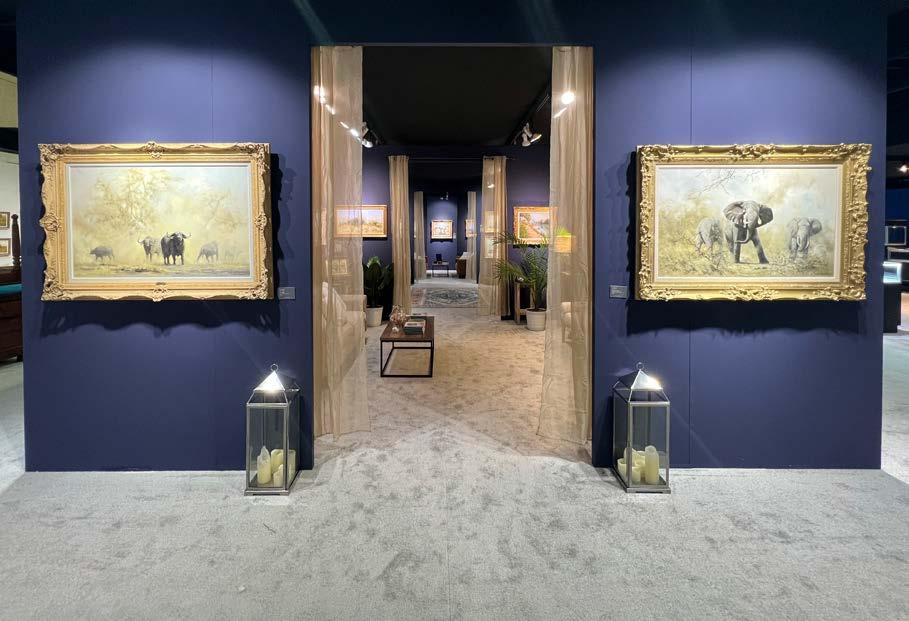

Gladwell & Patterson at the Palm Beach Show
Gladwell & Patterson are delighted to announce their return to the 20th Annual Palm Beach Show in January 2023 at the Palm Beach County Convention Center over Presidents’ Day Weekend. Regarded as the most luxurious and sophisticated showcase of its kind in the United States, the Palm Beach Show remains the Florida’s best high-end Art Fair offering items spanning every genre; juxtaposing many periods and movements.

Gladwell & Patterson celebrate a historic 275 years in 2023, making us London’s oldest art gallery. Over the course of our 275 years, the gallery has always sought out the finest artists and their work. We have carefully curated an exquisite selection of artworks especially for The Palm Beach Show, which will showcase the very finest paintings that we have to offer.
The highlight of our exhibition will be an exclusive first showing of a unique bronze relief sculpture cast from a linocut by Pablo Picasso of his last and final love, Jacqueline Roque. In memorialising this linocut, conceived in 1962, in bronze, Picasso made a statement expressing not only the importance he attributed to his printmaking methods, but to the individual quality of this composition with Jacqueline at its heart.

Gladwell & Patterson are proud to present an exceptional collection of five PostImpressionist landscapes by Gustave Loiseau, one of the leading artists in this movement. These paintings offer a unique perspective into Loiseau’s evolvement from his Impressionist period of the early 1900s, to his formative later works from the late 1920s, where his technique verges on abstraction. Alongside these we will be showcasing Post-Impressionist masterpieces by Georges Charles Robin and Alexandre Louis Jacob to bring the beauty of the European countryside to the sunny climes of Florida. The gallery has dealt with these artists since the Second World War and will be publishing the Catalogue Raisonné of both artists works in the near future.
Alongside these greats of Eurpoean art, we are thrilled to announce that we will be showing new works by acclaimed British artist Peter Wileman exclusively at The Palm Beach Show. As Peter’s only dealer in the United States we are excited to be bringing his work to the American market.
Booth 900/1001
16 – 21 February 2023
Palm Beach County Convention Center 650 Okeechobee Blvd. West Palm Beach FL 33401
glenn@gladwellpatterson.com
+44 (0) 7767 824 245
Cory Fuller
cory@gladwellpatterson.com
+44 (0) 7866 450 070
Emily Campin
emily@gladwellpatterson.com


+44 (0) 7983 518 526
Graham Magee
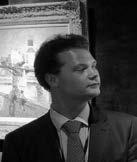
graham@gladwellpatterson.com
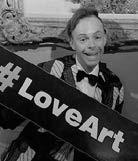
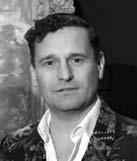
+44 (0) 7775 900 251
Will Stewart
will@gladwellpatterson.com
+44 (0) 7702 108 198
Glenn Fuller
Looking Forward to the Past: An Illustrious 275 Years

Gladwell & Patterson is proud to be London’s oldest art gallery. Founded in 1746, by the greatest print merchant of Georgian London, John Boydell, our business has always had the goal of dealing with the finest artists of their generation. We value quality and integrity very highly, and we understand the passion and creativity that comes hand-in-hand with being so talented.
Founded in the City of London, the gallery is proud to have remained an essential destination for anyone in search of fine paintings and sculpture. It has become apparent everyone remembers their first encounter with the gallery, and no wonder - over our centuries of history we have been committed to delivering wholesome and enjoyable experience to anyone who walks through our doors or visits our stands at Art Fairs across the globe.
The gallery’s history traverses many artistic movements, it contains incredible beauty, the wonder and power of artistic creation and its ability to bring such joy, contentment and unity to the World. The foundations of this fine art gallery are based on the pioneering and passionate work of many giants of the art world over the past 275 years. Their number include two Lord Mayors of London, a man who is credited with being the driving force behind the establishment of the National Gallery, the Head of the Fine Art Trade Guild and Masters of several of the Worshipful Companies in the City, amongst many other accolades.
The earliest custodians of our business, John Boydell in the eighteenth-century, and Henry Graves in the nineteenth-century, were the most successful print merchants in London at the time, specialising in publishing engravings from pictures by Joseph Mallord Wiliam Turner, John Constable, John Everett Millais, and other contemporary painters.

T. H. Gladwell was opened by Thomas Henry Gladwell, the son of a very talented carver and gilder, at 21 Gracechurch Street, in 1836. Initially, the gallery specialised in fine prints, books, and stationery, but with his father’s knowledge of carving and gilding, it wasn’t long before they had added frame making to their repertoire. By the time of Thomas Gladwells’s death in 1879, the business had firmly established itself as one of the leading art galleries and frame makers in London. Thomas’s three sons, Henry, Arthur and Alfred took over the business and renamed it Gladwell Brothers in 1880. Their extensive network of fine artists continued to expand and through their connections with European dealers and publishers such as the dealer Théodore Vibert, the publisher Alfred Cadart, and the dealer Adolphe Goupil, were vital in maintaining their position as one of the most ground-breaking, interesting, and knowledgeable art gallery in London.
Harry Gladwell, the eldest grandson of Thomas Henry Gladwell, would eventually take over the business at the start of the twentieth-century. Brought up as a hard-working, inquisitive, and religious lad, he yearned to join his father and uncles in the business. In 1875, aged eighteen, the intrepid Harry travelled to Paris to be apprenticed with the art dealer Adolphe Goupil in Paris. There, he became firm friends with another apprentice, Vincent van Gogh, who took the young Harry under his wing and showed him around the city. Vincent delighted in Harry’s idiosyncratic appearance, describing him as "thin as a stick with a pair of large red protruding ears", and his joie de vivre. Van Gogh’s letters to his brother Theo reveal the close relationship between the two young men.
Harry moved the gallery to its new home on the corner of 70 & 71 Cheapside, in the City of London; which soon became known as Gladwell’s Corner. With Harry’s experience gained through his various apprenticeships with his uncles and father and his spell at Goupils in Paris, he would go on to become the most successful art dealer of his time.
Two of Harry’s sons, Ernest and Algernon, joined their father at Gladwell & Company, learning the trade at the various branches of the company. In 1928, a year after Harry Gladwell died, the brothers went their separate ways. Algernon remained in the City and moved to a new gallery at the corner of Queen Victoria Street and Watling Street, where the gallery remained until 2012.


In 1968, Algernon retired and sold the business to Herbert Fuller, who had managed the gallery for him since 1932 and had been instrumental in steering the gallery through the hardships of the 1930s and then the blitz of London during the Second World War. Following the War, Algernon and Herbert regularly travelled to the Salons of Europe, meeting the best and most highly regarded artists with whom they started prosperous relationships. Herbert brought renowned French masters such as Georges Robin, Alexandre Jacob, Charles Perron, Edouard-Léon Cortès and Auguste Bouvard into the Gladwells fold. He introduced these artists to the British art market and subsequently around the world.
The same year that Herbert acquired Gadwell & Company, in 1968, his son Anthony Fuller joined him in the business. Father and son continued to take the gallery from strength to strength, cementing Gladwell & Company’s place as the most discreet and discerning Fine Art Gallery in London. It was the destination for any art collector wanting to build an honest and beautiful collection.
Upon Herbert’s untimely death in 1980, Anthony took over the company, and worked tirelessly to keep the old established gallery going. Anthony’s love of art soon found him his own group of clients, and there are precious few people who have met him in the gallery over the years who don’t comment on the infectious joy that paintings give him. Many people’s love of art has been founded on a few minutes in Anthony’s company with some paintings.
Anthony’s son Glenn joined the business in 1995, followed by his daughter, Cory, in 1998, following a successful and invaluable Masters degree at the Courtauld Institute of Art. In 2004, the Fuller family acquired the prestigious Mayfair gallery W H Patterson at 19 Albemarle Street. The gallery was opened in 1964 by Bill Patterson and became known as the premier gallery for contemporary artists painting in traditional styles, and artists from around the world wished to be represented by them.
In 2012, our two galleries in the City and in Mayfair were brought together under one roof in the equally distinguished environment of Knightsbridge. It is here, with the opening of Gladwell & Patterson, that two illustrious legacies combined in our new space at 5 Beauchamp Place, where we remain to this day.
In 2020, we opened the doors to Gladwells Rutland in the exclusive market town of Oakham in Rutland, offering a new and intimate space in which to show the works of our wonderful artists in the British countryside.
The Gladwell & Patterson ethos has been shaped by an informed yet fresh approach to what the separate parts have always done: presenting the finest works of art to those who appreciate them most, our perceptive, valued clients.
1
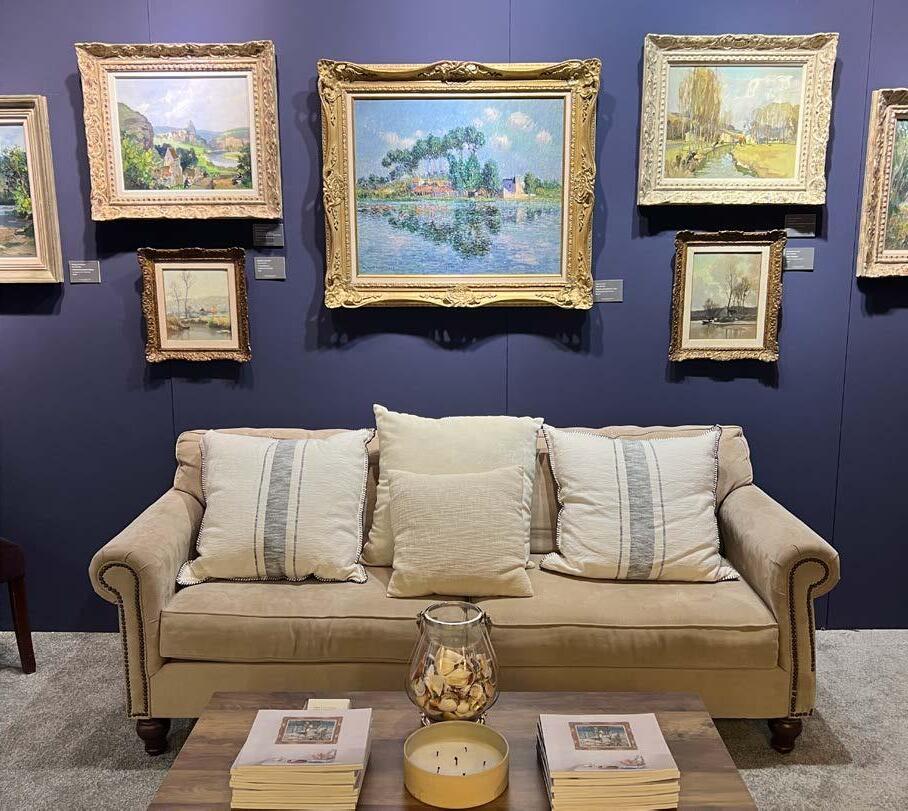
Gustave Loiseau French, (1865-1935)
One of the foremost Post-Impressionist painters, Gustave Loiseau was profoundly influenced by the great masterpieces of the Impressionists. A champion of painting the landscape en plein air , Loiseau embraced the use of bold colour as he explored and expanded the Impressionist style.
Loiseau rebelled against the traditional practices of painting and joined the famous artists’ colony at Pont-Aven in Brittany in 1890. There he became companions with Henry Moret, Maxime Maufra and Paul Gauguin and under their influence, Loiseau embraced the use of bold colour and sought to expand and seek new aspects of the Impressionist style. In his quest to create movement and light, Loiseau developed a distinct cross-hatching technique which resulted in the supple and ephemeral quality for which his work is known.
In 1895, Loiseau was introduced to the renowned Parisian art dealer Paul Durand-Ruel, by Claude Monet and Auguste Renoir, with whom he agreed an exclusive contract to sell his paintings. Loiseau’s first solo exhibition at Galerie Durand-Ruel took place from March to April in 1898.
The hallmark of truly great painters has always their ability to develop and adapt their style throughout the course of a career, while still staying true to their artistic goals. In this respect, Gustave Loiseau is without peer. In his quest to explore complex and often overlooked atmospheric effects, he would continually adapt and innovate over the course of his life.
After his early years under Gaugin at Pont-Aven, in 1898 Loiseau began to synthesise the styles of Claude Monet and Camille Pissarro: combining the en plein air subjects of the former with the divisionist brushwork of the latter to study the rural landscapes of Northern France. His 1898 Les Peupliers and 1899 Le Chemin en Bord de Rivière brilliantly illustrate the novel technique which would win him the support of his great champion and dealer Paul Durand-Ruel. The approach found in these works would culminate in the striking naturalism of his 1907-1908 period, captured in Peupliers sur les bords de l’Yonne
Despite the successes of 1898 to 1907, Loiseau’s desire to capture the complexity of atmosphere and light compelled him to adopt more fluid brushwork and complex colouration, a change evident in the bold purples and vigorous textures of his 1913 Rivière en Normandie Even in his mature career, Loiseau continued to innovate, mostly notably creating a novel, cross-hatched "en trellis" technique which he used to powerful effects in works like his 1929 Place de L’Étoile
3
Les Peupliers
Painted in 1898
Signed ‘G. Loiseau’ (lower left)
Oil on Canvas
81 x 65 cms / 32” x 25½”
Gustave Loiseau
French, (1865-1935)
Provenance
Durand-Ruel, Paris.
Private Collection, Switzerland.
Sale; De Quay-Lombrail, Paris, France, 7th December 1995, Lot 13.
Private Collection, New York.
Michelle Rosenfeld Gallery, New York.
Sale; Sotheby’s, New York, 14th May 1997, lot 147; sold by the above.
Private Collection, New York.
Gladwell & Patterson, London; acquired in May 2021.
Exhibitions
Galerie Durand-Ruel, Paris, Exposition de tableaux de M. Gustave Loiseau, 26th March – 9th April 1898.
This work is sold with a certificate of authenticity and will be included in the forthcoming Catalogue Raisonné being prepared by Didier Imbert.
4

5

6
Gustave Loiseau
French, (1865-1935)
Les Peupliers depicts a vibrant landscape of the countryside surrounding the village of Nwesle-la-Vallée where Loiseau lived from 1890. Painted in 1898 at a pivotal point in the artists career, this magnificent landscape represents the coming together of Loiseau’s greatest influences, the Pont-Aven School and Loiseau’s Impressionists forbears, and reveals the young artists immeasurable talent and keen eye for observation through his ability to depict an atmospheric landscape through his application of paint.
The bold colours of Les Peupliers exemplifies Maufra and Moret’s influence on the young artist following his time in Pont-Aven earlier in the 1890s. Meanwhile, the handling of paint and Loiseau’s use of dappled directional brushstrokes reveal his debt to the Impressionists, particularly Alfred Sisley. For Sisley, as for most of the Impressionists, it was the ability to portray the effects of outdoor light that was of such importance and which meant that the smoothness of the finished work, much valued in traditional painting, would give way for a more textured surface. Sisley applied paint with thick impasto brushstrokes to create texture and contrast throughout his compositions. Sisley referred to this as the ‘animation of the surface’ and built-up layers of paint in response to the landscape in front of him. This free, broken brushstroke became one of the hallmarks of the Impressionists and was wholeheartedly embraced by Loiseau and his fellow Post-Impressionists. Following Sisley’s example, through interweaving colours, and added texture, Loiseau built up his characteristic atmospheric landscapes.
Encouraged and fostered by the most important figures of the art world in the late nineteenth and early twentieth century, Loiseau painted this exquisite work at a pivotal point in his career, and it was subsequently included in his very first solo exhibition at Galerie Durand-Ruel, which took place from March to April in 1898. No exhibition catalogue was made for this exhibition, however Les Peupliers was first sold through Durand-Ruel in Paris and a review in La Revue Blanche by the art critic Thadée Natanson described landscapes depicting a range of scenes including ‘trembling haystacks and poplar trees’ which provides strong evidence that this painting was exhibited in Loiseau’s very first solo exhibition with Durand-Ruel.
The brushwork and vibrant colours of Les Peupliers reveal Loiseau’s profound skill in capturing the ambiance of nature. The vibrating colour harmonies of the field of golden wheat and the gestural brushstrokes of the gently swaying poplars enliven this sun drenched pastoral scene. Identifiable through a rich surface, composed using spontaneous brushwork as the pigment is layered upon the canvas, this masterful painting reveals the artists experimental nature and exemplifies Loiseau’s instinctive use of both Impressionist and PostImpressionist techniques in his quest to capture nature as he experienced it en plein air
7
Le Chemin en Bord de Rivière
Painted circa 1899-1900
Signed ‘G. Loiseau’ (lower right)
Oil on Canvas
50 x 61 cms / 19½” x 24”
Gustave Loiseau
French, (1865-1935)
Provenance
Galerie Atelier Matignon, Paris.
Mr. and Mrs. James R. Holland, New York.
MacConnal-Mason, London.
Private Collection, England; acquired from the above in March 2018.
Gladwell & Patterson, London; acquired from the above in April 2022.
The Authenticity of this work has been confirmed by Didier Imbert and this work is issued with a certificate of authenticity dated 2014.
8

9

Gustave Loiseau
French, (1865-1935)
Le Chemin en Bord de Rivière is a masterful evocation of a breezy autumnal day. Painted at the turn of the century between 1899 and 1900, at the height of Loiseau’s Impressionist period, the work embodies the young artists influence of his Impressionist forebears, most notably that of Alfred Sisley and Claude Monet.
Le Chemin en Bord de Rivière embodies the influence of Loiseau's Impressionist forebears, most notably that of Alfred Sisley and Claude Monet. Painted en plein air , Loiseau set up his easel on the river bank to capture a lone figure walking along the tow path, isolated in the midst of nature and the broad expanse of the sweeping curve of the river. Despite the season, the present landscape is far from barren, the scene enlivened by thick and staccato impasto. His rich palette full of deep browns, bright reds and vibrant greens set against the cool blue of a nearing winter’s sky and the light purples of the trees on the horizon highlight Loiseau’s virtuosity with colour.
The riverbanks of the Seine were clearly an enormous impetus for Loiseau’s style, for it was in 1899 that his early technique gave way to the virtuosic impressionist style for which the artist is best known as the artist produced a series of stunning riverscapes. Setting up his easel on the towpaths around Tournedos, Loiseau captured the boats, houses and trees of the Seine in all seasons and weather. Le Chemin en Bord de Rivière fits comfortably into this group of seminal 1899 works, displaying all the compositional maturity and technical ability that had secured Loiseau’s position as a leading Post-Impressionist artist.
Le Chemin en Bord de Rivière is a brilliant example of the artist’s drive to capture more complex conditions. Despite the season, the present landscape is far from barren, the scene enlivened by thick and staccato impasto in the path, river and also the house. Here we admire Loiseau’s quick, sweeping brushstrokes across the sky, re-creating the clouds scudding across the cool autumnal sky. His rich palette full of deep browns, bright reds and vibrant greens set against the cool blue of a nearing winter’s sky and the light purples of the trees on the horizon highlight Loiseau’s virtuosity with colour. As usual, Loiseau has layered on the paint here with precision, building up the texture that is vibrant and interesting when viewed up close, and magical once we step back to admire the scene as a whole.
11

12
Peupliers sur les bords de l’Yonne
Painted in 1907
Signed ‘G Loiseau 1907’ (lower left)
Oil on Canvas
60.3 x 73.3 cms / 23¾” x 28¾”
Gustave Loiseau
French, (1865-1935)
Provenance
Durand-Ruel, Paris; acquired from the artist on 24 July 1907.
Durand-Ruel, New York; acquired from the above in October 1908.
Schoneman Gallery, New Work; acquired from the above on 21 October 1946.
Private Collection, Beatriz Arsimendi de Plaza and Jose Luis Plaza, Venezuala.
Private Collection; acquired as a gift from the above.
Gladwell & Patterson, London; acquired from the above in 2022.
Exhibited
Durand-Ruel, Paris, Tableaux par Gustave Loiseau, 1908, no. 8.
This work will be included in the forthcoming Catalogue Raisonné being prepared by Didier Imbert.
13
Gustave Loiseau
French, (1865-1935)
Peupliers sur les bords de l’Yonne reveals the masterful treatment of one of Loiseau’s most emblematic subjects: poplars by a riverside. In his focus upon poplars as a subject, Loiseau pays homage to the landscapes of Alfred Sisley and Claude Monet; most notably the latter is series of twenty-four views of poplars on the bank of the Epte in the spring of 1891.
The evocative composition of Peupliers sur les bords de l’Yonne depicts a bright summers day on the banks of the Yonne. The current work is a rare example of one of the few river scenes that the artist produced outside of Auxerre in 1907, and stands as a wonderful evocation of the French countryside at the pinnacle of Loiseau’s Impressionist manner.
Painted upstream from Auxerre, Peupliers sur les bords de l’Yonne is devoid of any human figures; Loiseau instead focuses on the fleeting light effects and gentle calm of the flowing river. The dappled reflections on the surface of the water are beautifully rendered in loose brushstrokes of thickly applied impasto oil paint. The layered impasto creates a distinction between land, water and sky as well as recreating the texture of the grasses, trees, and houses on the opposite bank. The painting resonates with the atmospheric quality of a warm summers day with a light breeze. The broad expanse of the river Yonne in the foreground delights the senses as Loiseau superbly captures the rippling effect of a warm breeze blowing across the surface of the water. This still and serene landscape is animated by the movement of the clouds in the sky, painted with longer, loose brushstrokes than their reflections in the water below, evoking a calming ambiance. Loiseau masterly depicted the clouded sky and abundant foliage with the use of delicate feathered brushstrokes, reminiscent of Monet’s technique.
Peupliers sur les bords de l’Yonne reveals the masterful treatment of one of Loiseau’s most emblematic subjects: poplars by a riverside. With their strict linearity and intrinsic decorative elegance, poplar trees were a favoured artistic motif in the late nineteenth and early twentieth century. Their slender height is often the only vertical compositional feature to be found in rural imagery, meaning that they tend to represent the best way to balance the strong horizontals typically found in riverscapes.
The painting’s rich surface, composed using spontaneous brushwork and areas of thickly applied paint, exemplifies Loiseau’s experimental nature. This still and serene landscape is animated by the movement of the gently rolling clouds in the sky, painted with loose, featherlike brushstrokes. Transient images of foliage dotted on the riverbank are captured in spontaneous, almost brushed strokes in a pointillist manner.Loiseau's technique and the chromatic variety of his palette express an extraordinary ability to synthesise Impressionism and Post-Impressionism.
14
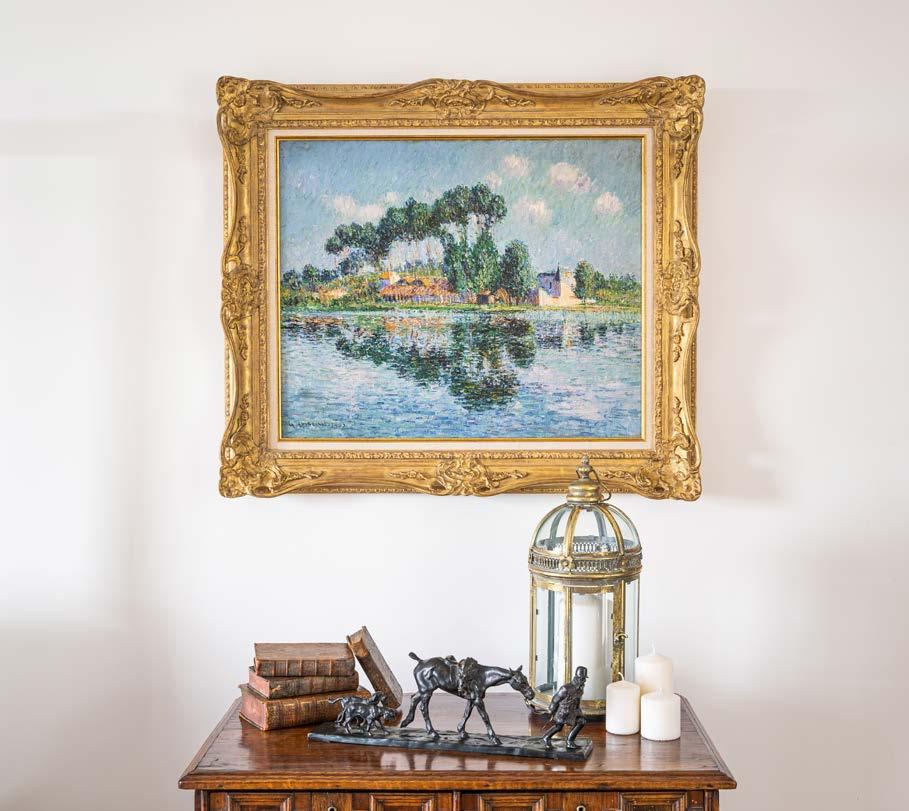
15

16
Rivière en Normandie
Painted in 1913
Signed ‘G Loiseau 1913’ (lower right)
Oil on Canvas
54 x 65 cms / 21½" x 25¾"
Gustave Loiseau
French, (1865-1935)
Provenance
Galerie Félix Vercel, Paris.
Private Collection, Paris; acquired from the above.
Private Collection, by descent from the above.
Sale; Artcurial, Paris, 4th December 2012, lot 65.
Private Collection, acquired at the above sale.
Sale; Sotheby’s, London, 1st Mar 2018, lot 367.
Private Collection, UK; acquired from the above.
The authenticity of this work has been confirmed by Didier Imbert and this work is issued with a certificate of authenticity dated 2012.
17
Gustave Loiseau
French, (1865-1935)
A richly atmospheric painting, Rivière en Normandie captures the unique violet light of the late afternoon, delineated through a complex matrix of purple brushstrokes with which Loiseau suffuses the vivid green banks of River Eure.
The Eure, a tributary of the Seine which runs between Normandy and Centre-Val de Loire in north-western France, was a favoured theme to which Loiseau returned on many occasions throughout his artistic career. Only a few kilometres from the River Seine, the area offered a wealth of inspiration for a follower of the Impressionists. Amongst the artist’s favoured river scenes, the Eure dominates Loiseau’s pictorial output to a far greater extent than any other waterway.
As part of his project to capture more complex weather conditions and atmospheres than his Impressionist forebears, Loiseau often returned to his favourite settings multiple times. Loiseau thus painted the Eure in all seasons and at various times throughout the day; veiled by the morning mist, lit by bright sunlight or, as in Rivière en Normandie , in the complex purple light of the early evening. This view of the Eure, so loved by the artist, recalls the work of the Monet and Sisley in its themes and composition, however Loiseau’s technique and innovative brushwork adds a brilliant atmosphere and vibrancy to the composition which is entirely the artist’s own.
The broad expanse of the river in the foreground delights the senses as Loiseau superbly captures the rippling effect of a wind blowing across the surface of the water. This energetic landscape is animated by the movement of the rolling clouds in the sky, painted with longer, looser brushstrokes than their reflections in the water below. Where Loiseau delineates the foreground in straight vertical and horizontal touches, he instead conceives of his clouds as a cluster of circular strokes, suggesting a swirling and eddying movement of wind.
The way Loiseau has captured movement in Rivière en Normandie is outstanding. Swift brushstrokes dance across the canvas to the left, conveying the sway of the tall trees in the background. It seems that Loiseau must have sought to contrast the upper and lower registers of his painting. Where the sweep of foliage on the riverbank is captured in spontaneous, almost brushed strokes, the clouds and tops of the poplars are rendered in larger, more heavily worked patches of colour. Thus, where the foreground of the painting remains still, as the viewer’s gaze progresses up the canvas these larger strokes give an increasing impression of movement.
In around 1913, the artist rapidly began to adopt a much freer pictorial approach, characterised by a looser application of paint and a turn towards increasingly intense pigments. Rivière en Normandie therefore represents one of the first works in a period of great experiment throughout the 1910s, and is one of a small group of paintings that would set the tone for the rest of the artist’s career.
18
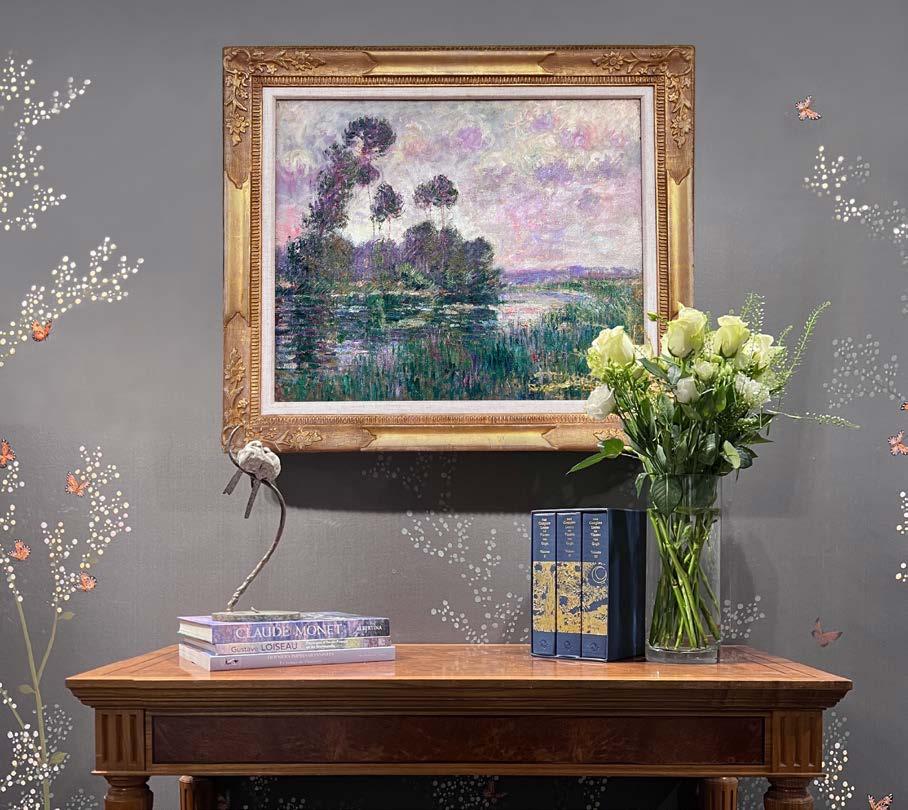
19
La Place de L’Étoile
3
Painted in circa 1929
Signed ‘G Loiseau’ (lower left)
Oil on Canvas
54.5 x 65 cms / 21½" x 25½"
Gustave Loiseau
French, (1865-1935)
Provenance
The Modern Art Foundation, Geneva, no. 1224.
Sale; Christie’s, London, 27 June 1989, lot 353.
Sale; Christie’s, London, 26 June 1996, lot 150.
Private Collection, USA.
Sale; Christie’s, London, 3 February 2004, lot 160.
Private Collection, Canada.
Sale; Christie’s, London, 24 June 2010, lot 413.
Sale; Sotheby’s, New York, 15 November 2016, lot 107.
Private Collection, Florida, USA.
Gladwell & Patterson, London; acquired from the above in 2022.
Exhibited
Geneva, Petit Palais, Post-Impressionnisme (1880-1910), July – September 1980.
Literature
'Gustave Loiseau', in Style, Vol. II, 1963 (illustrated pp. 80-83).
Journal de l'amateur d'Art, Paris, no. 486, 2 December 1971 (illustrated p. 6).
This work will be included in the forthcoming Catalogue Raisonné being prepared by Didier Imbert.
20

21
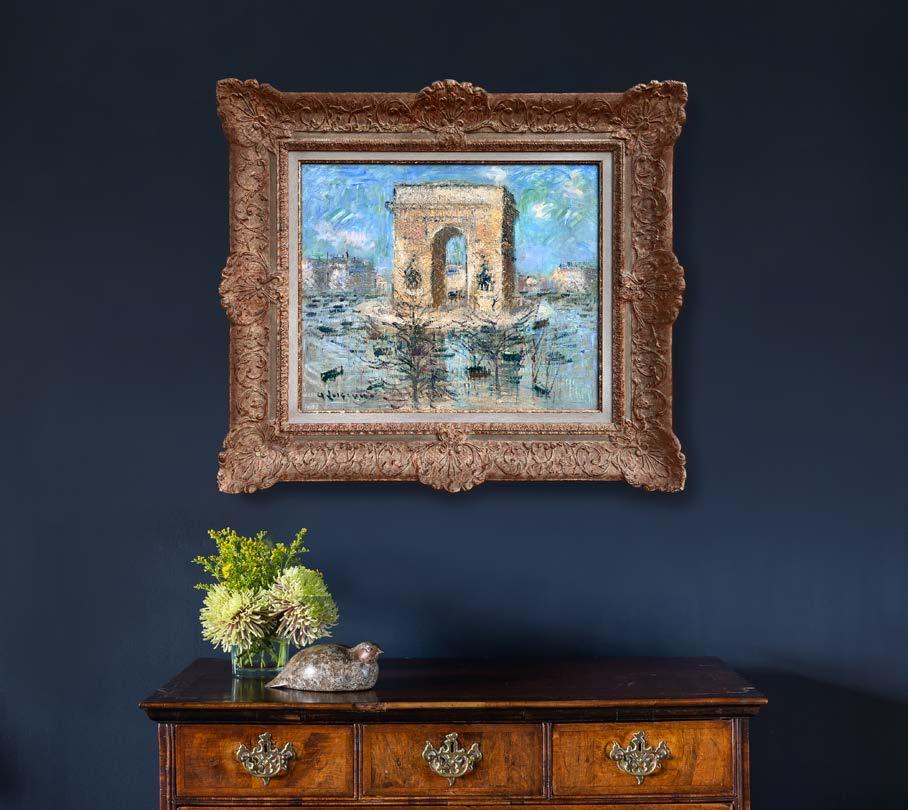
Gustave Loiseau
French, (1865-1935)
La Place de L’Étoile was painted in 1929, during a period in which Loiseau depicted the Arc de Triomphe from various viewpoints throughout the cold winter months. Painted in the later years of Loiseau’s artistic career, this subtle winter cityscape stands out amongst the artists’ mature œuvre for its distinctive post-impressionist brushwork and exemplifies the unique cross hatching technique for which Loiseau is known.
In the 1920s, Loiseau began to spend increasing time in Paris at the encouragement of Durand-Ruel. While he kept his studio on the Quai du Pothuis in Pontoise, his successes allowed him to open a second studio in the capital on the Quai d’Anjou. Loiseau was thus able to continue to capture the waterways of Northern France in spring and summer, but in the winter his attention turned to the urban environment. Although the artist would initially paint smaller scale works directly from his studio window, by the mid 1920s he would increasingly turn towards larger scale Parisian subjects. Three settings in particular are emblematic of the artist’s work in Paris: the Rue de Clignancourt, the Place de la Bastille, and of course the Place de l’Étoile.
The Place de l’Étoile, now renamed Place Charles de Gaulle after the president’s death in 1970, is the iconic meeting point for twelve avenues which converge on the Napoleon’s Arc de Triomphe as part of Baron Haussmann’s renovation of Paris in the 1860s. Multiple Impressionists would make these new boulevards the subjects of their work, from Caillebotte’s Rainy Day to Pissarro’s views of the Boulevard Montmartre, yet it would be Loiseau who first systematically studied the Place de l’Étoile. These wide streets had been favoured by artists as emblems of modernity since their inception, and Loiseau’s work continues in this vein, providing an early depiction of circulating streetcars on one of Paris’s busiest junctions.
By the late 1920s, when Loiseau painted La Place de l’Étoile , he had already enjoyed considerable success both in Paris and abroad, where he was emerging as one of the few artists that were able to expand and seek new aspects of the Impressionist style. In his quest to create movement and light, Loiseau had developed a distinct style of the ‘cross hatching’ technique, referred to as ‘en treillis’ (latticework), thereby creating the supple and ephemeral quality for which his work is known. In La Place de l’Étoile , Loiseau applied this unique technique to the Arc de Triomphe. A homogeneous and yet vibrating colour structure is created by his staccato-like brushwork, developed from the pointillism of Seurat and Signac.
La Place de l’Étoile , like so many of Loiseau’s best works, represents the synthesis of impressionist subjects and preoccupations with the artist’s own unique pictorial language. Constructed around the monumentality of the Arc de Triomphe, the artist creates a composition which succinctly balances the circular movement of modern traffic with the solidity of the iconic landmark. La Place de l’Étoile thus serves as one of the best encapsulations of Loiseau’s continued experimentation into his late career.
23
Georges Charles Robin
French, (1903–2002)
Recognised as one of the best, but largely undiscovered, Post-Impressionist artists, Georges Charles Robin’s skill and complete command of his palette set him aside from his contemporaries. Following the en plein air practice of the Impressionist masters, in a few swift brushstrokes Robin brought life to the trees and rivers of the French countryside.
Robin was born in Paris. He studied at École des Beaux-Arts under the master painter Paul Michel Dupuy. Robin went on to become a well-known decorative artist, before securing a job as the scenery artist for the Charleville Theatre and the Dinan Casino.
Robin lived in the affluent suburb of Rueil Malmaison on the western outskirts of Paris throughout his life. The summer months were often spent near Morlaix in Brittany where Robin had a second home; there he would capture idyllic seascapes and charming river estuaries bathed in sunshine. However, throughout Robin’s career the Loire Valley and the Dordogne region inspired his greatest works.
Enthralled by the enchanting river valleys of rural France that flowed through the luxuriant countryside and rolling fields, Robin’s paintings perfectly capture rural French life.
Following the en plein air practice of the Impressionist masters, in a few swift brushstrokes, Robin brought life to the trees and rivers of the French countryside. Robin was a master at capturing the change in temperature and atmosphere. His restrained use of colour allowed him to capture a warm summer’s afternoon or a blanket of snow with profound skill. Combining his deft and delicate touch with vigorous, dramatic brushstrokes and palette knife work, he produced exceptional landscapes. Robin's skill in emphasising nature's basic structure and his sympathetic interpretation using pure colouring only enhances his total control of the medium of oil paint. His love of nature in all her moods inspires a fine sense of permanence in his craft and his treatment of the rustic architecture that exists in many of the towns and villages of France is unrivalled.
Robin was a member of the Salon des Artistes Français, the Salon des Paysagistes Français, and the Society of Arts, Science and Letters. He was an officer of the Académie des Beaux Arts, director of the Institute of “Instruction Publique”, and a former Professor of the Technical High School. He was highly lauded, achieving virtually every major award in French painting for his work, among which the Hors Concors stands out as one of the highest and most esteemed awards of an artist of the time.
Gladwell & Patterson’s history with this distinguished artist began after the Second World War. Herbert Fuller of Gladwell & Company, London, discovered the landscapes of Robin in the Paris Salon in 1948, and approached the artist in his studio. Since he first set eyes on Robin’s landscapes in Paris, Herbert Fuller, and the two subsequent generations of the Fuller family of Gladwell & Patterson have continued to share the legacy of this great artist. The gallery has both an outstanding library of his work and a highly cultivated knowledge of his practice. We are currently preparing a Catalogue Raisonné of his work.
24
Sur Le Loing, Le Matin, près de Nemours
Oil on Canvas
46 x 55 cms / 18" x 21½"
Provenance
Private Collection, France.
Gladwell & Patterson, London; acquired from the above in 2020.
Exhibited
Exibited at the Paris Salon, after 1948.
Le Moulin de Gazals sur L'Aveyron
Oil on Canvas
44.5 x 53 cms / 17½" x 21"
Provenance
Private Collection, Cholet, France.


Gladwell & Patterson, London; acquired from the above in 2021.
Exhibited
Exibited at the Paris Salon, after 1948.
25
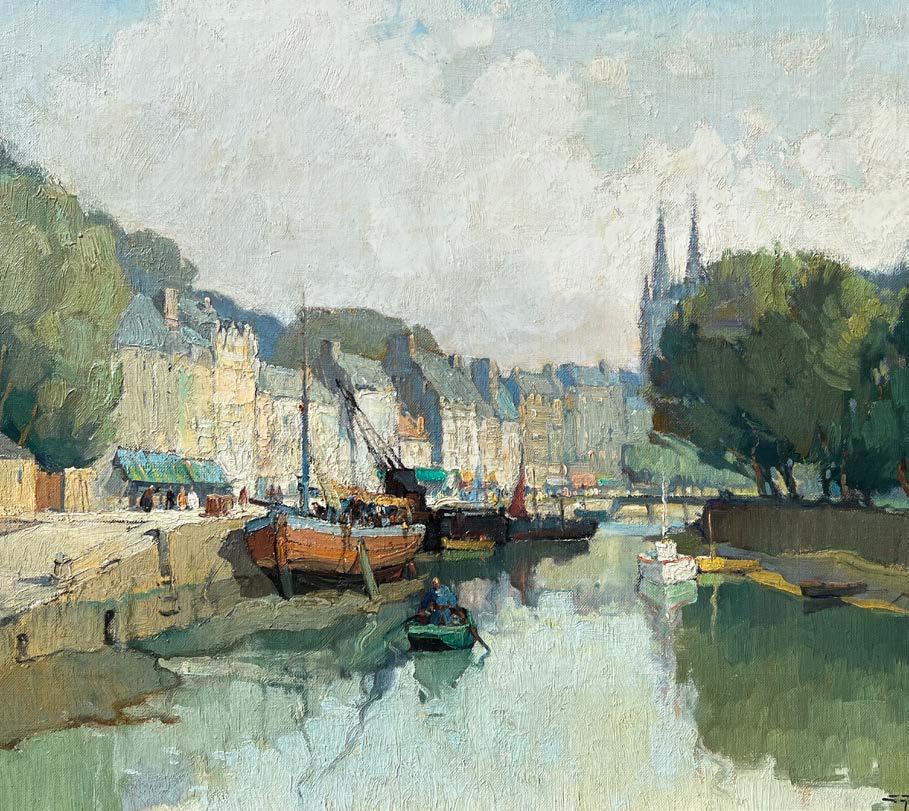
26
Oil on Canvas
46 x 53.5 cms cms / 18" x 21"
Georges Charles Robin
French, (1903–2002)
Provenance
Galerie Otto, Vienna.
Gladwell & Co., London (Stock Number 10026); acquired from the above in September 1962.
Private Collection, UK; acquired from the above in November 1962.
Gladwell & Co., London (Stock Number 15641); acquired from the above in December 1987.
Private Collection, Jersey, Channel Islands); acquired from the above in May 1988.
Gladwell & Patterson, London; acquired from the above in 2022.

Le Port de Quimper
27
Vallée du l'Aveyron à Penne - Ruines du Château d'Adelaide de Penne
Oil on Canvas
38 x 46 cms / 15" x 18"
Provenance
Private Collection, France.
Gladwell & Patterson, London; acquired from the above in 2022.
Exhibited
Exibited at the Paris Salon, after 1948.
Calvignac et le Lot

Oil on Canvas
46 x 55 cms / 18" x 21¾"
Provenance
Private Collection, France.

Gladwell & Patterson, London; acquired from the above in 2022.
Exhibited
Exibited at the Paris Salon, after 1948.
28
Georges Charles Robin
French, (1903–2002)
Les Gorges du Loup et Village de Tourette
Oil on Canvas
46 x 55 cms / 18" x 21¾"

Provenance
Private Collection, France.
Gladwell & Patterson, London; acquired from the above in 2022.
Exhibited
Exibited at the Paris Salon, after 1948.
La Mauldre, près de Mareil
Painted in 1962

Oil on Board
39 x 46 cms / 15½" x 18"
Provenance
Omell Galleries, London.
Private Collection, UK.
Gladwell & Patterson, London; acquired from the above in 2019.
29
Sur le Thouaret, près de Thouars
Oil on Canvas
46 x 54 cms / 18" x 21½"
Georges Charles Robin
French, (1903–2002)
Provenance
Priavte Collection, UK.
Gladwell & Patterson, London; acquired from the above.
30

31

32
Pierre-Eugène Montézin
French, (1874–1946)
The last great Post-Impressionist painter, Pierre Eugène Montézin would be instrumental in maintaining the vitality of landscape painting well into the twentieth century. With a career spanning over fifty years, Montézin championed Impressionism into the modern era; his legacy ensuring its survival for generations to come. Building upon unimpeachable en plein air technique, his use of pure colours and richly textured brushwork make his works immediately recognisable: their bright light and complex atmospheric effects are still startlingly vibrant to the viewer. Yet Montézin understood that art needed more than technical brilliance, noting to the critic Louis Vauxelles that ‘the subjects of the Landscape painter are less in from of the artist’s eyes than they are in his heart’. Amongst a litany of great achievements, his 1923 receipt of the Légion d’Honneur for a landscape painting shown at the salon is widely regarded as a seminal moment for not only twentieth century Impressionism, but en plein air painting as a whole. The first award of this magnitude for a landscape for three decades, it prompted an explosive critical reaction that forever cemented Montézin’s reputation. By the time that he passed away while painting outdoors (the same fate that befell Cézanne) Montézin had been made both President of the Académie des Beaux Arts and head of the Salon Jury, a testament to the universal esteem in which he was held.
Barques près des Arbres
Oil on Canvas
66 x 54 cms, 26" x 21½"
Provenance
Private Collection, France. Gladwell & Patterson; acquired in 2018.
33
Agapito Casas Abarca
Spanish, (1874-1964)

Provenance
Private Collection, Barcelona. Gladwell & Patterson, London; acquired from the above in 2021.
on
37 x 41 cms / 14½” x 16¼”
View of Camprodon
Oil
Board
34
Georges Ricard-Cordingley
French, (1873-1939)

Oil on Canvas
41 x 50.5 cms / 16” x 19¾”
Provenance
Gabrielle Ricard-Cordingley (daughter of the artist). Gladwell & Patterson, London; acquired from the above in 2022.
Jeune Normande Assise sur la Plage
35
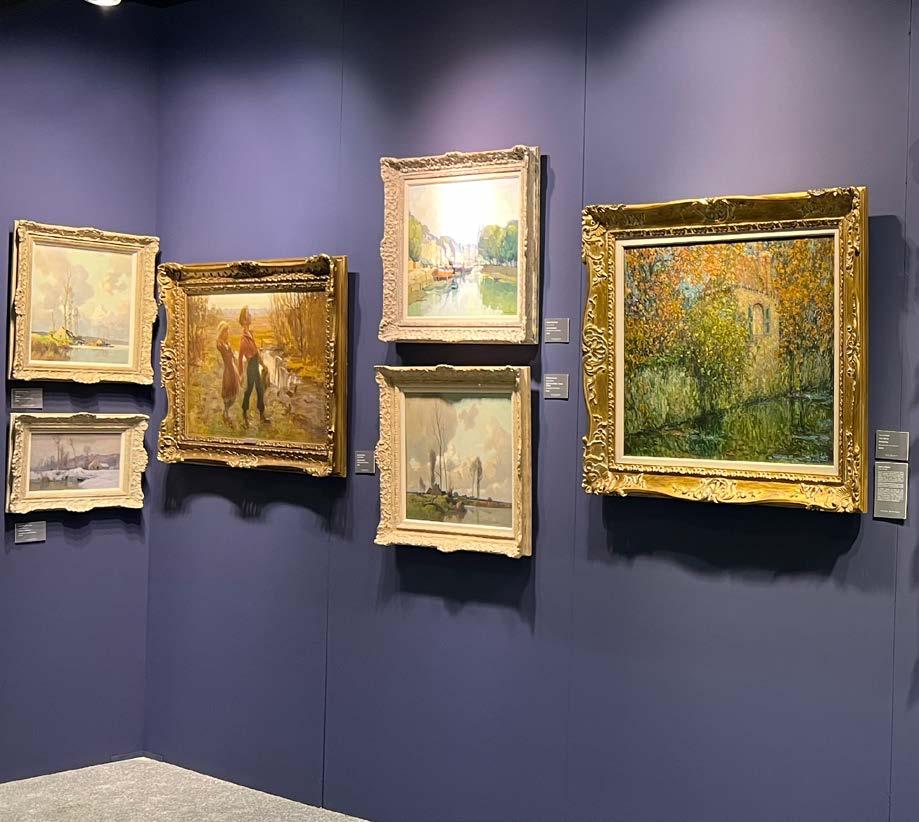
36

37
Promenade Automnale au Bord de la Rivière

Oil on Canvas
46 x 55 cms / 18” x 21½"
Provenance
Private Collection, France. Gladwell & Patterson, London; acquired in 2021.
38
Alexandre Louis Jacob
French, (1876-1972)
Alexandre Louis Jacob is best known for his atmospheric and luminous landscapes. He gained his rare understanding and love for nature through studied inspection, transferring his observations skillfully on to canvas. His masterful evocation of light, atmosphere, colour and sense of place are remarkable, and have a true ability to transport the viewer to the very banks of the River Seine and River Marne where Jacob would patiently wait, paintbrush poised to capture his unique visions of the French countryside.
Throughout his career, it was the endless skies of the French landscape that appealed to Jacob. The horizon sits in the lower third of his compositions, with the focus on fleeting clouds above, fringed with luminous light. The vast open skies create a sense of calm and contemplation, punctuated by elongated poplar trees that rise from below. Jacob was a master at capturing the French landscape as it subtly changed between the seasons. In autumn, his paintings contain a golden aura, in winter, a soft creamy light diffuses across the landscape with hues of pinks and blues reflected in snow on the river banks and his depictions of springtime resonate with the crisp morning light. Jacob preferred to paint in the quiet moments after a storm had passed, and each of his landscapes have a unique atmosphere of calm and tranquility, achieved by the still watery reflections in the foreground.
Herbert Fuller, of Gladwell & Company, London, first came across Jacob’s work in the Paris Salon after the Second World War, and it was at this point that Jacob’s work began to attract the international clientele of this historic art gallery in the City of London. Initially Jacob was represented by Galerie Haussmann in Paris, but as his popularity grew, Gladwell & Company acquired work directly from the artist from the early 1960’s until Jacob’s death in 1972.
In recent years, Gladwell & Patterson have had the good fortune to collect some unique drawings by Jacob which the artist would send to his close friends at Christmas and New Year. They reveal the artists direct observation of nature, sketching out his compositions with brown and black pencil. Jacob heightened these drawings with white chalk, picking out a smooth reflection upon the surface of water or the glowing clouds in an endless sky. These sepia toned landscape sketches, like Jacob’s exquisite oil paintings, have a unique atmosphere of calm and tranquility, achieved by the still watery reflections in the foreground.
Since Jacob’s death, three generations of the Fuller family of Gladwell & Patterson have continued to place Jacob’s illuminating oil paintings in illustrious private collections worldwide. In recent years, Jacob’s paintings have risen in popularity. Gladwell & Patterson is currently preparing a Catalogue Raisonné of his work.
39
Éclaircie sur le Marais, Environs d’Amiens
Painted in 1920


Oil on Canvas
46 x 56 cms / 18” x 22”
Provenance
Private French Collection.
Leighton Fine Art, UK.
Gladwell & Patterson, London; acquired from the above in 2021.
40
Étude Temps Gris, Seine-et-Marne

Oil on Canvas
31 x 24 cms / 12½" x 9½"
Alexandre Louis Jacob
French, (1876-1972)
Provenance
Private Collection, UK.
Gladwell & Patterson, London; acquired from the above in 2020.
41
Autumn
Oil on Canvas
36 x 44.5 cms / 14¼" x 17½"
Provenance
Galerie Hausmann, Paris.
Watson Art Galleries, Montreal, Canada; acquired in 1951.
Private Collection; acquired from the above on 7 March 1955.

Private Collection, New York State, USA.
Gladwell & Patterson, London; acquired from the above in 2022.
Oil on Canvas
46 x 55 cms / 18" x 21¾"
Provenance
Private Collection, France.
Gladwell & Patterson, London; acquired in 2022. Exhibited Paris Salon, after 1937.
Soleil Couchant au Bord de la Marne, Les Bùcherons
Alexandre Louis Jacob
42
French, (1876-1972)

43
Vieux Moulin, Temps Nuageux, Seine-et-Marne
Oil on Board

38.5 x 41.5 cms / 15¼" x 16¼"
Provenance
Galerie de Rohan, Paris. Gladwell & Co., London; acquired from the above in March 2002. Private Collection, UK; acquired from the above in August 2002.
44
Winter Evening

Oil on Panel 36 x 44.5 cms / 14¼" x 17½"
Provenance
European Art Imports, New Orleans, Louisiana. Mr and Mrs Sanford, USA; acquired from the above between 1975-1977, and thence by descent.
Gladwell & Patterson, London); acquired from the above in 2022.
A Tranquil Morning

Oil on Panel 27 x 23 cms / 10" x 9"
Provenance
Private Collection, UK. Gladwell & Patterson, London; acquired from the above in 2020.
French, (1876-1972)
Alexandre Louis Jacob
45
Côte Rocheuse
Oil on Canvas 66 x 81 cms / 26" x 32"
Paul Madeline
French, (1863-1920)

Provenance
Private Collection, France.
Gladwell & Patterson, London; acquired from the above in 2018.
Private Collection, UK.
Gladwell & Patterson, London; acquired from the above in 2022.
46
43 x 55 cms / 17" x 21½"
Jean-Baptiste Olive
French, (1848-1936)

Provenance
Private Collection, Texas. Gladwell & Patterson, London; acquired from the above in 2018.
View from the Cliffs, Marseilles, France
Oil on Canvas
47
Raymond Wintz
French, (1884-1956)
Celebrated as a “painter of light”, Joseph Raymond Wintz enjoyed a reputation as one of the finest artists working in France in the early twentieth century. Wintz’ skill and complete command of his palette set him aside from his contemporaries. He gained a firm appreciation by critics and collectors as a leading painter of the Brittany coastline and was renowned for his charming window and balcony scenes bathed in sunshine which perfectly embody memories of holidays by the coast.
Following his education, Wintz rejected the academic styles of his father and professors and like many of his contemporaries, decided to pursue his passion for painting outdoors ‘en plein air’ in the manner of the Impressionists. This technique demanded a free and spontaneous style of painting in order to catch the rapid changes in outdoor light. Wintz’ skill allowed him to extract the colours and shapes as well as the fragrances of nature, putting the total ambiance and experience directly onto the canvas. In a few swift brushstrokes, Wintz captured the very essence of Breton life.
Amongst Wintz’ most popular subjects are his delicately posed window and balcony scenes which allowed the artist to combine an interior and exterior setting within a single composition. This motif dates back to Renaissance traditions but was brought to the forefront of the twentieth century artistic imagination by Henri Matisse. Matisse exploited the window’s intrinsic duality - at once an opening and a barrier - to generate a tension between illusionistic depth and modernist flatness. Wintz’ interiors are simplistic, and he focuses the attention on the window or doorframe by placing a vase of vibrantly coloured flowers on a table or a windowsill providing a focus to the view beyond. Outside, boats sway in the quiet fishing ports and brightly coloured sails appear far out to sea on the horizon as Breton figures pass by bathed in the warm sunshine of a summer’s day. The delicate balance between the interior and exterior of these charming paintings celebrate, with arresting spontaneity, the warmth and brilliance of a Breton ‘room with a view’.
Perhaps Wintz’ best known painting is his 1924 work The Blue Door . Still in print after nearly a century, it conveys the artist’s most famous motifs: a vase containing geraniums or hydrangeas next to a subtly lit doorway overlooking a port. Painted in the Breton port of Döelan, the work would fully cement Wintz’ connection to the Breton coast. The success of The Blue Door would prompt Wintz to produce a similar image for the ‘Paint it Yourself Art Program’ popular in 1950s America. The artist would return to this motif throughout his career, and one of the most notable examples of these is The Green Door, Brittany
From 1951 to the present day, our gallery's historic archives reveal the unfaltering demand for Wintz’ exquisite Brittany landscapes and window scenes. Gladwell & Patterson has both an outstanding library of his work and a highly cultivated knowledge of his practice.
48
Golfe de Saint Tropez, Côte d'Azur

Oil on Canvas
54 x 65 cms / 21¼" x 25½"
Provenance
Private Collection, UK. Gladwell & Co., London; acquired in 2022.
49
The Green Door, Brittany
Oil on Canvas
53 x 64 cms / 21" x 25"
Raymond Wintz
French, (1884-1956)

Provenance
Private Collection, UK.
Gladwell & Co., London; acquired in 2006.
Private Collection, UK; acquired from the above in 2007.
Gladwell & Patterson, London; acquired from the above in 2022.
50

51
Bord de la Mer
Oil on Canvas
53 x 63.5 cms / 21" x 25"
Raymond Wintz
French, (1884-1956)

Provenance
Private Collection, France. Gladwell & Patterson, London; acquired from the above in 2021.
52
Renée Carpentier Wintz
French, (1913-2003)
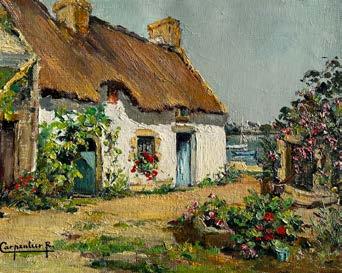
Chaumière au Puits Fleuri
Oil on Canvas
22 x 27 cms / 8¾" x 10½"
Provenance
Private Collection, France.
Gladwell & Patterson, London; acquired from the above in 2022.
Chaumière à Kergo
Oil on Canvas
22 x 27 cms / 8¾" x 10½"
Provenance
Private Collection, France.
Gladwell & Patterson, London; acquired from the above in 2022.
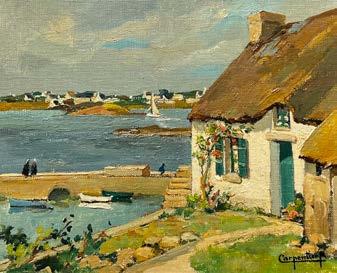
53
Les Roses Blanches
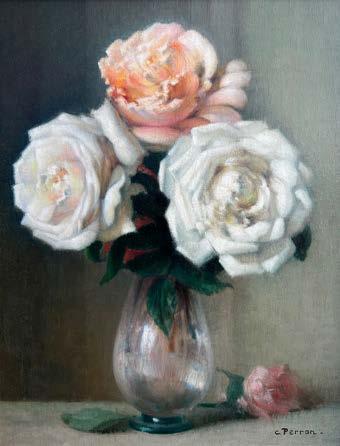
Oil on Panel
34.5 x 26.5 cms / 13½” x 10½”
Provenance
Private Collection, France.
Gladwell & Patterson, London; acquired from the above in 2021.
La Niche
Oil on Board

37 x 29 cms / 14½” x 11½”
Provenance
Private Collection, France.
Gladwell & Patterson, London; acquired from the above in 2022.
54
Charles Perron
French, (1893-1958)
Gladwells have been championing Charles Perron’s charming paintings since the early 1930s, when Herbert Fuller first encountered Perron’s paintings on a visit to the Salon des Artistes Français for their Summer Exhibition in Paris. Herbert Fuller was so enchanted with the captivating depictions of rural French life, be they the intimate cottage scenes, the delicate still lifes or the beguiling nudes, that he travelled to meet Charles at his studio in Nantes. The two gentlemen hit it off and there began a rewarding lifelong friendship which has extended between the families through the generations.
Perron’s studio was an ethereal and joyful place, full of light and beauty, and it is through Charles’ faultless technique and highly developed technical skills that he was able to translate all of this onto his canvases. With pure lines, reminiscent of Raphael and Michelangelo, and with compositions which draw comparisons from Chardin, Charles’ paintings drew acclaim from his peers, his patrons and indeed from the French establishment who awarded him many honours. Perron exhibited widely and gained several awards, including gold at the 1928 Salon and silver at the 1937 Exposition Universelle in Paris.
He had a complete mastery of shape and of delicate hues, a wonderful sense of design and an expert command of his chosen medium. His paintings bring a sense of calm and joy to the viewer and their quality simply stands out.
“In 1987 I met Perron’s daughter at an auction in Brittany; Madame Perron took me back to her father’s studio where his palette lay on the floor beside the easel, exactly where he put it on the day he died nearly thirty years earlier. This meeting renewed Gladwell’s relationship with the Perron family. I learnt that when the war began, the artist buried all of his paintings in his garden and moved to Brittany, where his subject matter expanded with the change of scenery. On the cessation of war Perron returned to his studio, dug up his pictures and resumed his career. The many accolades awarded him by the Art Institutes of France during his life confirm his status as one of the leading artists of his time. ”
- Anthony Fuller
55
Auguste Bouvard
French, (1875-1956)

Provenance
Private Collection, USA.
Gladwell & Patterson, London; acquired from the above in 2022.
au bord d’un cours d’eau
Canvas
cms
13”
18”
Hameau
Signed "Pelletier" Oil on
33 x 46
/
x
56
Bretagne, Retour de Pêche

Oil on Canvas
60 x 73 cms / 23½" x 28¾"
Georges Maroniez
French, (1865-1933)
Provenance
Private Collection, Paris.
Gladwell & Patterson, London; acquired from the above in 2022.
57
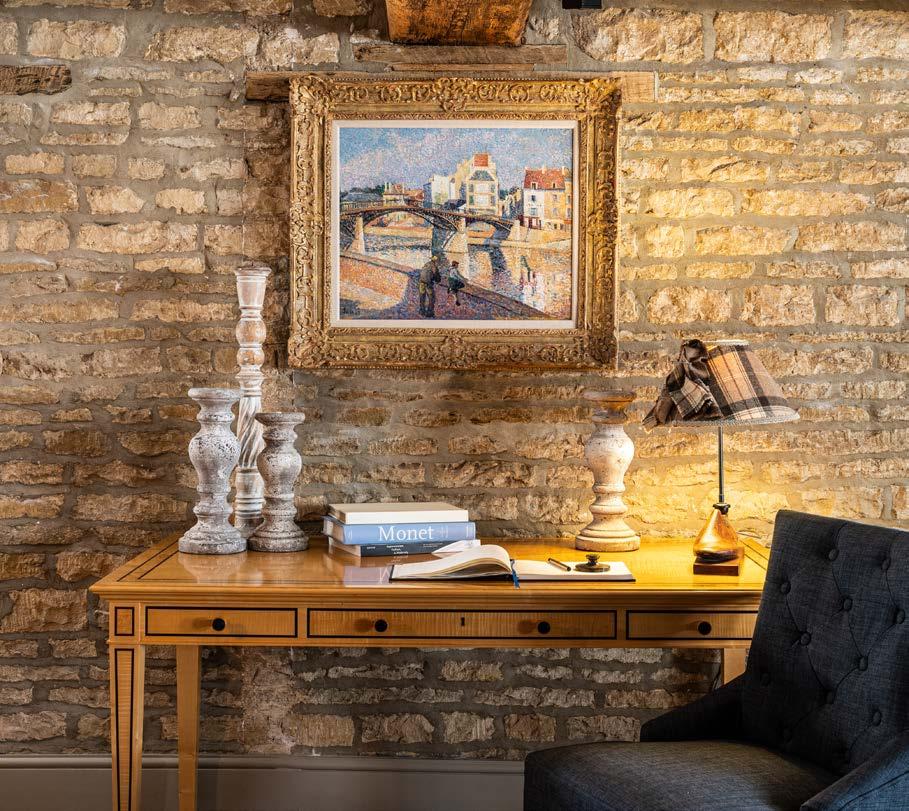
58
Lagny, le Pont de Fer sur la Marne
Painted in 1889
Signed ‘Luce 89’ (lower left)
Oil on Canvas
50 x 61 cms / 19¾” x 24”
Maximilien Luce
French, (1858–1941)
Provenance
Madame Z.
Sale, Drouot, Paris, 16 March 1991, lot 10.
Galerie Odermatt, Paris.
Richard Green, London. Private Collection, UK.
Gladwell & Patterson, London ; acquired from the above.
Exhibited
Lagny-sur-Marne, Musée Gatien-Bonnet, Autour des Néo-Impressionnistes, le groupe de Lagny, November 1999 - January 2000; this exhibition later travelled to Geneva, Petit-Palais, Musée d'art moderne, March - May 2000 and Sherbrooke, Musée des Beaux-Arts, September 2000 - January 2001.
Kochi, The Museum of Art, Georges Seurat et le Néo-Impressionnisme, 1885 - 1905, June - July 2002, no. 47, p. 138 (illustrated; titled 'Le pont de fer à Lagny-sur-Marne'); this exhibition later travelled to Utsunomiya, Museum of Art, July - September 2002; Kyoto, The National Museum of Modern Art, September - October 2002 and Tokyo, Seiji Togo Memorial Yasuda Kasai Museum of Art, October - December 2002.
Literature
Bazetoux, D., Maximilien Luce : Catalogue raisonné de l’œuvre peint, vol. III, Paris, 2005, no. 236, p. 94 (illustrated).
59
Maximilien Luce
French, (1858–1941)
Maximilien Luce was one of the original pioneers of the Neo-Impressionist movement. Often known as the pointillists, these painters sought to apply optical science to art for the first time, challenging the looser technique of the Impressionists. Using small brushstrokes, the style sought to create an unprecedented brightness and vitality by using the contrasts and harmonies revealed by the invention of the colour wheel; understanding for the first time that the viewer’s eye was able to synthesise these into natural tones. After its foundation by Georges Seurat in the mid 1880s, Luce would join the movement in 1887 and work closely with Seurat and his protégé Paul Signac.
Lagny, le Pont de Fer sur la Marne is one of a small corpus of works which hail from the first phase of Neo-Impressionism. The 1880s represents the movement at its most avant-garde, shocking both the Impressionists and the academic establishment, with its scientific technique. With its array of bright blues, greens and pinks, Luce demonstrates his masterful control of colour; creating rich shadows and bright highlights with a more varied brushwork than that exhibited by his contemporaries. Yet Lagny, le Pont de Fer sur la Marne represents more than a beautiful evocation of Neo-Impressionist technique. With its two mysterious foreground figures standing out amidst their suburban setting, Luce’s work is also a compelling document for the revolutionary aspirations that underpinned the tranquil surfaces of his canvases. Between pointillism and politics, Maximilien Luce’s painting is a rare and emblematic example of the NeoImpressionist project.
Luce’s varied brushstrokes and visible impasto contribute to create a work that feels far more alive than compositions by Seurat or Signac, who were often subject to complaints by contemporary critics that in their works ‘life had come to a standstill’. Brushwork and colour thus converge in the work of Luce; his palette is more muted than his fellow artists, but his works nonetheless achieve a more naturalistic finish. The colouring of Lagny, le Pont de Fer sur la Marne represents a symphony in orange and purple that unifies sky, reflection and shadow. The artist’s complex use of pinks and purples was noted at only his second appearance at the Salon, with the crtic Jules Christophe noting that across the ‘ten important canvases by Maximilien Luce … all are harmonized in violet’. Luce’s inventive Neo-Impressionist technique allows the painting to be suffused throughout with the colour’s warm tones, unifying the diverse areas of colour across the composition.
In his 1898 treatise on painting, Signac made the argument that for art to be significant it had to ‘consist of both compositional harmony and moral harmony’, and it is these twin facets that define Luce’s career and Lagny, le Pont de Fer sur la Marne in particular. The accomplished brushwork and scientific colouring imbues the painting with a warmth and life that helps to further its utopian message. At the same time, the presence of its complex figures ensures that there is a point to all of the complex technique demanded by NeoImpressionism.
60

61

62
Charles Henri Verbrugghe
French, (1877-1974)
Few artists have cultivated an association with a city as strong as that between Charles Henri Verbrug-ghe and Bruges. Through brilliant colours and boldly textured brushwork, Verbrugghe set the standard for capturing the complex light of Bruges’ canals and medieval alleyways, setting a standard for depic-tions of the city that have rarely been matched.
Born in Bruges in 1877, and largely self-taught, Verbrugghe would move to Paris in 1905 and settle in Montmartre; at the time the epicentre of modern art. Forming close personal friendships with Maurice Utrillo and especially Kees Van Dongen, Verbrugghe would go on to socialise with Edgar Degas, Pierre-Auguste Renoir, and Claude Monet at the famous cabaret “The Lapin Agile” during his years in Paris.
Despite moving in Modernist circles, it would be the Impressionists who most influenced Verbrugghe’s mature style. Across a nearly eighty year career, Verbrugghe perfected his cityscapes in France and Italy, yet it would be his home town of Bruges, where he retruned to each summer, that exerted the great-est pull as a subject.
Pont du Cheval à Bruges, Le Soir
Oil on Panel
48 x 59 cms, 19" x 23"
Provenance
Private Collection, France.
Gladwell & Patterson, London ; acquired from the above in 2015.
63
Maurice Martin
French, (1894-1978)
A master of bold colours and strong form, Maurice Martin was a key practitioner in the Moret School of painting. Encouraged by a strong passion for landscape painting, Martin travelled to Moret sur Loing, not far from the more famous Barbizon region. There he became close friends with Henry Moret and his school of Impressionist painters, who lived and worked close to this picturesque town in central France, and who were themselves profoundly influenced by the innovative creativity of the four leading lights of Impressionism: Claude Monet, Pierre-Auguste Renoir, Camille Pissarro and Alfred Sisley. Martin was encouraged to practice ‘en plein air’ painting and the use of pure colour, believing that this technique was the only way to capture the immediacy of the outdoor scenery.
The technique used by Martin demanded a free and spontaneous style of painting in order to catch the rapid changes in outdoor light. Martin attempted to extract the colours and shapes as well as the fragrances of nature, putting the total ambiance and experience directly onto the canvas. As a general rule, artists from prior schools of classical training chose to absorb the experience of nature into mental and emotional images or perhaps even sketches and then return to the silent studio where they organized their thoughts and interpreted them onto canvas. Martin’s ethos was the complete opposite. The primary motivation for Martin, born out of the teachings of the Moret School, was to go through the woods with his paints and canvasses capturing a piece of nature at an exact prescribed time, thus eliminating the intellectual character of landscape painting. He believed that a landscape should be viewed purely as a moment of beauty.
Martin was a tall man and in his words, “saw from high up”. Yet his paintings are always impeccable in their perception, are well-lit and full of grace. His many landscapes include studies of Picardy, the Île-de-France, Brittany and Provence. He also painted in Spain, particularly in Grenada and Malaga, capturing with the tip of his brush the dances of sunlight he so much loved.
Pommiers en fleurs à Villemaréchal
Oil on Canvas
54 x 65 cms / 21" x 25½"

Provenance
Private Collection, Arles, France. Gladwell & Patterson, London; acquired from the above in 2022.
64
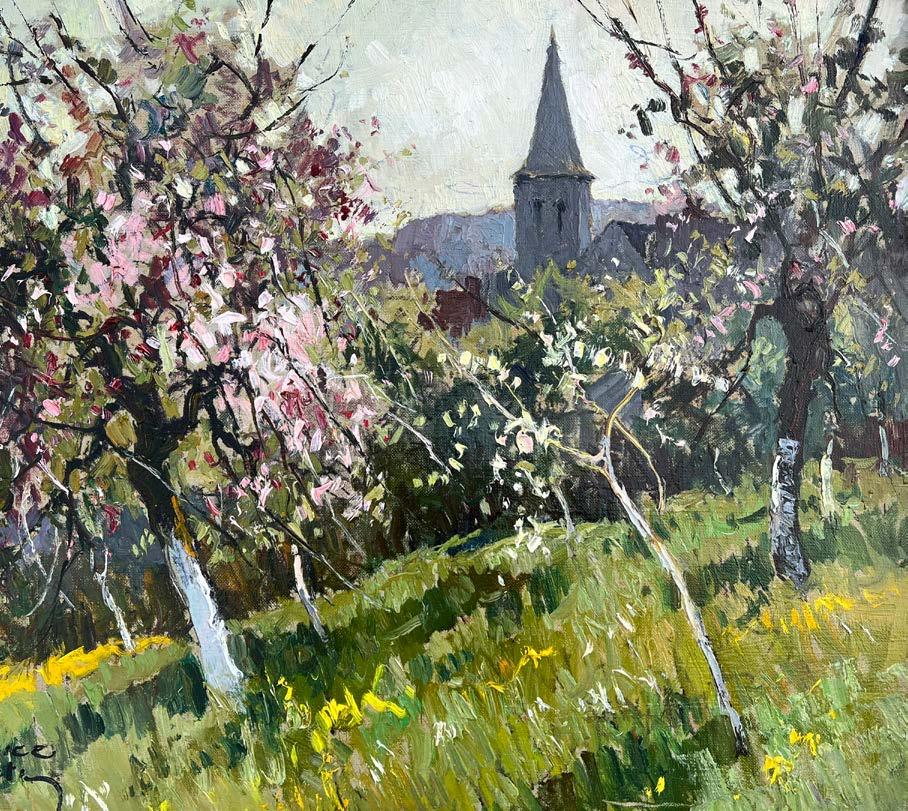
65
Evening Glow
Painted in 1916
Signed ‘Le Sidaner’ (lower left)
Oil on Canvas
65 x 81 cms / 25½" x 31¾"
Henri Le Sidaner
French, (1862-1939)
Provenance
Georges Bergaud (director of the Galerie Georges Petit).
Louis Loucheur; acquired from the above.
Private Collection, France.
Sale; Salle Galliéra, Paris, 18 June 1961, lot 51.
Private Collection, France.
Gladwell & Patterson, London, acquired from the above in 2022.
Literature
Yann Farinaux-Le Sidaner, Henri Le Sidaner : Paysages Intimes, (Editions Monelle Hayot, 2013), n°355, reproduced p.146.
66

67

68
Henri Le Sidaner
French, (1862-1939)
A contemporary of the Post-Impressionists, Henri Le Sidaner’s approach to painting is whole-heartedly unique. His technique was often close to Pointillism, but Le Sidaner did not share the Pointillists’ love of colour, preferring greys and opals to create mystery and atmosphere. Instead, he used Pointillist techniques to make the surfaces of his paintings shimmer and blur.
Since moving to the picturesque, hill-top village of Gerberoy in northern France in 1901, Le Sidaner’s seductive views of his gardens, with their recently vacated tables dappled in sunlight and overhung by roses, would cement his reputation as a unique and unclassifiable artist. Le Sidaner spent the summer months in Gerberory, but escaped the cold winter’s by travelling elsewhere in France. In 1914, he purchased a second home in Versailles, which quickly became his favorite residence.
In September of 1916, Le Sidaner would return to Gerberoy to spend a week enjoying the company of his close friend, the Belgian poet Emile Verhaeren. Nominated for a nobel prize on six separate occasions and instrumental in the symbolist movement, Verhaeren was one of the leading exponents of French poetry and provided a constant source of support and inspiration for Le Sidaner in his early career. Whilst in Gerberoy with Verhaeren, Le Sidaner produced multiple studies of the small summer pavilion which he had constructed next to his rose garden. It was these studies which inspired Le Sidaner to create Evening Glow , upon his return to Versailles. The painting is a fusion of the artists’ Gerberoy pavilion with the canals and autumnal impressions of Versailles. Le Sidaner elongated the square pavilion into a rectangular shape in order to better integrate it with the composition of Evening Glow
Painted at the height of his career, Evening Glow is characteristic of Le Sidaner’s most verdant and richly textured compositions from the 1910s. The brightly lit window at the centre of the painting still animates the quiet scene, implying but not confirming human presence. The sense of understated mystery and gentle poetry that Le Sidaner has imbued this work with reveals the artist’s inheritance from his Symbolist-inspired early years and his friendship with Verhaeren; while the brighter and more intense elements of the palette, the subtly worked contrasts and the dappled application of pigment evokes his debt to Impressionism.
After completing Evening Glow , Le Sidaner likely showed the painting to Verhaeren in November, where they met for a final time before the poet’s tragic death in a train accident later in the month. Soon after, the painting was bought from the Galerie Georges Petit by the industrialist Louis Loucheur, a senior figure in the French government and avid art collector. A great supporter of Les Nabis (his portrait by Vuillard can still be seen in Lille), Loucheur was a highly discerning collector whose endorsement of Evening Glow is testament to its quality.
69
Rue de la Paix, Paris
Oil on Canvas
33 x 46 cms / 13" x 18"
Édouard Cortès
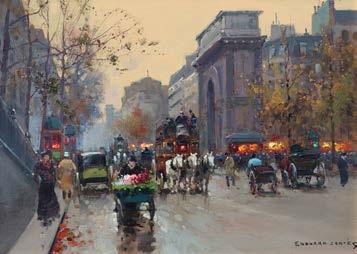
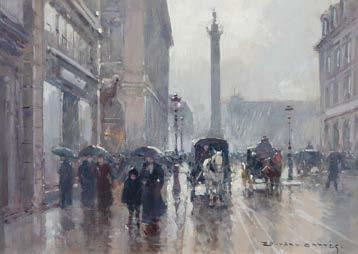
French, (1882-1969)
Provenance
Gladwell & Co., London.
Private Collection, UK.
Gladwell & Patterson, London; acquired from the above in 2022.
Porte Saint Denis, Paris
Oil on Board
33 x 46 cms / 13" x 18"
Provenance
Gladwell & Co., London. Private Collection, UK.
Gladwell & Patterson, London; acquired from the above in 2022.
70
Marché aux Fleurs, Place de la Madeleine, Paris
Oil on Canvas
46 x 76 cms / 18" x 30"
Provenance
Private Collection, France. Gladwell & Patterson, London; acquired in 2021.
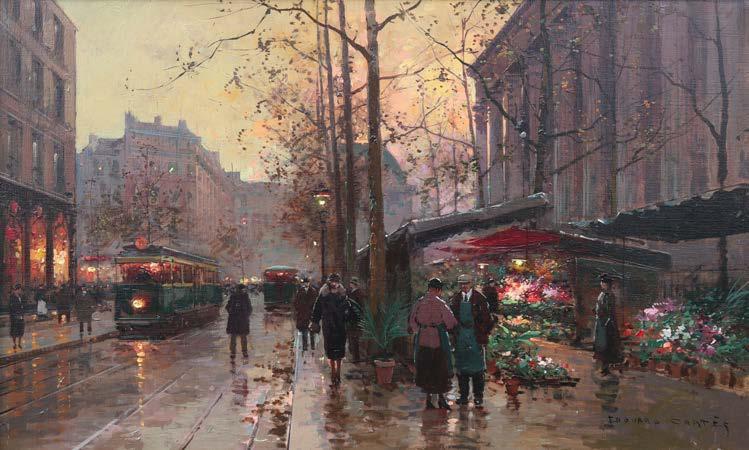
71
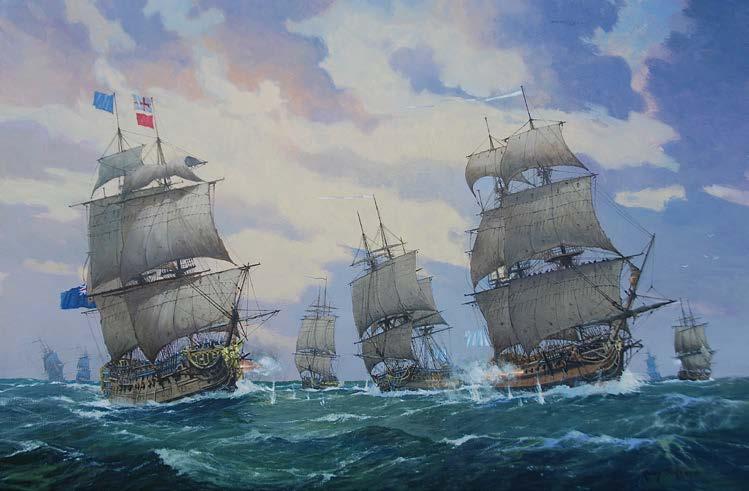
The Battle of Quiberon Bay Oil on Canvas 61 x 90 cms / 24" x 35½" 72
Ronny Moorgat
Belgian, (Contemporary)
Ronny Moortgat is one of the foremost contemporary artists of marine painting. Following in the footsteps of the great maritime masters of the twentieth-century, he depicts his subjects with great discipline, capturing every minute detail of the vessels.
Moorgat’s skill in portraying contemporary and historic ships with such accuracy, whilst also imbuing their unique spirit in his paintings, is due to his lifelong passion for the sea and all that sail on her. This passion was born from growing up by the River Schelde close to Antwerp, Europe’s second largest port, and watching the hustle and bustle of the shipping from a very young age.
Trained as a technical draftsman, Moortgat has since combined his own more Impressionist approach with the strictly classical. Loose brushstrokes and the evocation of detail and atmosphere characterise his work. Further to maritime scenes, Ronny also paints landscape and still life scenes, the latter of which evoke the style of the Flemish Old Masters and bear testimony to his classical artistic education. In recent years, Moortgat has turned his attention to majestic, large scale battlescenes which depict small ship engagements in the period 1793-1815 as the Revolutionary and Napoleonic conflicts in Europe expanded to the scale of a proto-world war. This was the real beginning of the Royal Navy as the unchallenged thassalocratic power.
The Battle of Quiberon Bay , depicts a martitine batte which took place in 1759. This battle was the decisive naval engagement of the Seven Years War, a crushing victory by the Royal Navy over the French Fleet in their own coastal waters. Moortgat emphasises the rough seas that defined the engagement. The British three-decker in the foreground, possibly the 100-gun Royal George, is shown with most of her gun ports closed due to the swell of the violent North Westerly wind.
Quiberon Bay was a hugely important battle, and heralded the start of a half-century when Britain clamped down on the waves and became the world’s maritime hegemon. It was also seen as the premier victory in Britain’s Annus Mirabilis of 1759. With Britain and Prussia facing every other major European power, the Royal Navy had to hold the seas while Frederick the Great won the continental land war. As the conflict raged in the Indian and American theatres, the war is often described as the first ‘World War’, and as such control of the seas was critical to the eventual Anglo-Prussian victory.
73

USS Constitution at Nightfall Oil on Canvas 41 x 61 cms / 16" x 24" 74
Nantucket Habour

Oil on Panel 30 x 40 cms / 12" x 16"
Ronny Moorgat
Belgian, (Contemporary)
75
Ronny Moorgat
Belgian, (Contemporary)
The Battle
of the
Nile II Watercolour 33 x 53.5 cms / 13" x 21"
76

77
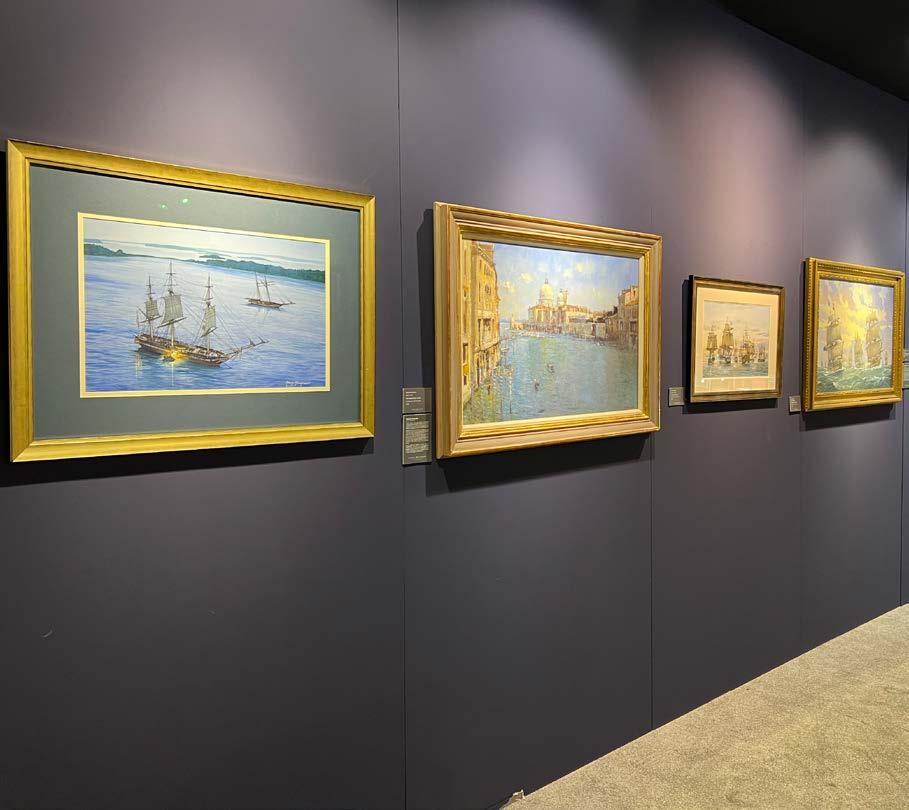
78
Matthew Alexander
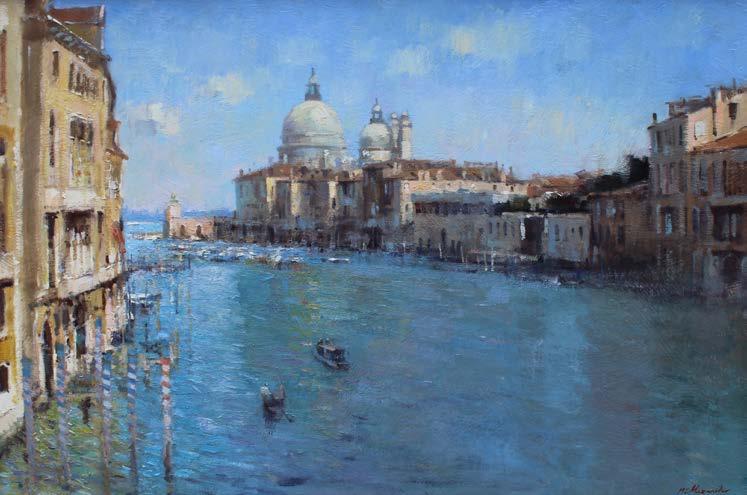
British, (Contemporary)
Provenance
Private Collection, UK. Gladwell & Patterson, London; acquired in 2019.
61
91
/ 24"
36"
The Grand Canal, Venice Oil on Board
x
cms
x
79

Francisco Miralles y Galup
(1848-1901 On the River Bank Oil on Canvas 59.5 x 49 cms / 23½” x 19¼” Provenance Private Collection, Florida. 80
French,
Oil on Canvas
40 x 45 cms / 15¾" x 17¾"
Filippo Anivitti
Italian, (1876-1955)

Provenance
Private Collection, Switzerland. Gladwell & Patterson, London; acquired from the above.
Fioraia della Scalinata di Trinità dei Monti
81
Francesco Bergamini
Italian, (1851-1900)

Provenance
Gladwell & Co., London. Private Collection, UK. Gladwell & Patterson, London; acquired from the above in 2022.
The Lesson Oil on Canvas 26 x 40 cms / 10" x 15½"
82
After Dinner, Rest Awhile
Oil on Canvas
46 x 61 cms / 18" x 24"
Margaret Dovaston
British, (1884-1954)
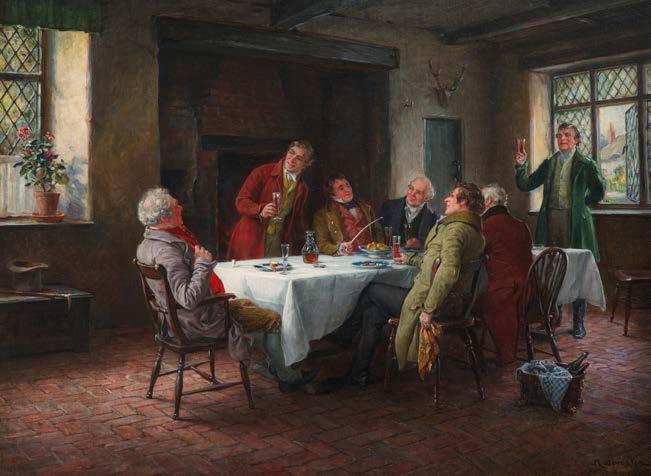
Provenance
Gladwell & Co., London. Private Collection, UK. Gladwell & Patterson, London; acquired from the above.
83
What can we see?
Oil on Canvas
56 x 90 cms / 22” x 36”
Provenance
Private Collection, USA.
Gladwell & Patterson, London, acquired from the above in 2021.

84
Adam Emory Albright
American, (1862-1957)
The Barefoot Boy by John Greenleaf Whittier
Barefoot boy, with cheek of tan! With thy turned-up pantaloons, And thy merry whistled tunes; With thy red lip, redder still Kissed by strawberries on the hill; With the sunshine on thy face, Through thy torn brim’s jaunty grace; From my heart I give thee joy, --I was once a barefoot boy!
85
Adam Emory Albright
American, (1862-1957)
Adam Emory Albright was one of the most successful painters working in Chicago at the beginning of the twentieth century. The charm and sentimental nature of his stunning depictions of barefoot country children struck a chord with Midwestern audiences and secured his artistic reputation.
Albright’s charming visions of childhood adventures encapsulates the poetry of the nineteenth-century writers John Whitcombe Riley and John Greenleaf Whittier. Albright’s popularity is largely due to the feeling of nostalgia evoked by these paintings, and the feeling of innocence and idealized childhood pleasure they recall. Using his twin sons and local street children as models, Albright would create works that located poor urban youths in bucolic settings.
Widely collected by the finest institutions in America during his lifetime; including the Art Institute of Chicago, the St. Louis Art Museum, and the Toledo Museum of Art. Such was his popularity in his adopted home of Chicago that he would be five solo exhibitions at the Art Institute, more than any artist in the first half of the 20th century. Today, Albright’s delicately painted visions of carefree children enjoying the delights of nature remain as celebrated today for their timeless elegance and the innocent simplicity of their subject.
These paintings are exquisite examples of Albright’s much lauded works of young children in their pursuit of simple country life. His impressionistic technique of fleeting, quick brushstrokes accentuate the children’s lightness of movement and the gently blurring of lines provides a dreamlike quality. The artist’s ability to convey texture comes to the fore in the work, with Albright’s impressionistic, wet-onwet technique brilliantly conveying the relaxed posture and clothing of the children, the waterlogged browns on the landscape, and the green shoots of new growth that spring up around their feet. With his favourite three colour palette of rose-madder, cobalt blue and chrome yellow he shapes a wonderous, almost pastel like landscape where the gently sloping hills become the backdrop for the wilderness and a meandering brook reflecting a myriad of surrounding colours. The warming sun is palpable as it highlights the two figures and their oneness with nature. Like all children, they are alone in their world of adventure where time has ceased to exist. …For a brief moment, we are allowed to enter their magical world and can reminisce of times past.
86
A Moment’s Rest
Oil on Canvas
51 x 90 cms / 20¼” x 36”
Provenance
Private Collection, USA.
Gladwell & Patterson, London, acquired from the above in 2021.

87
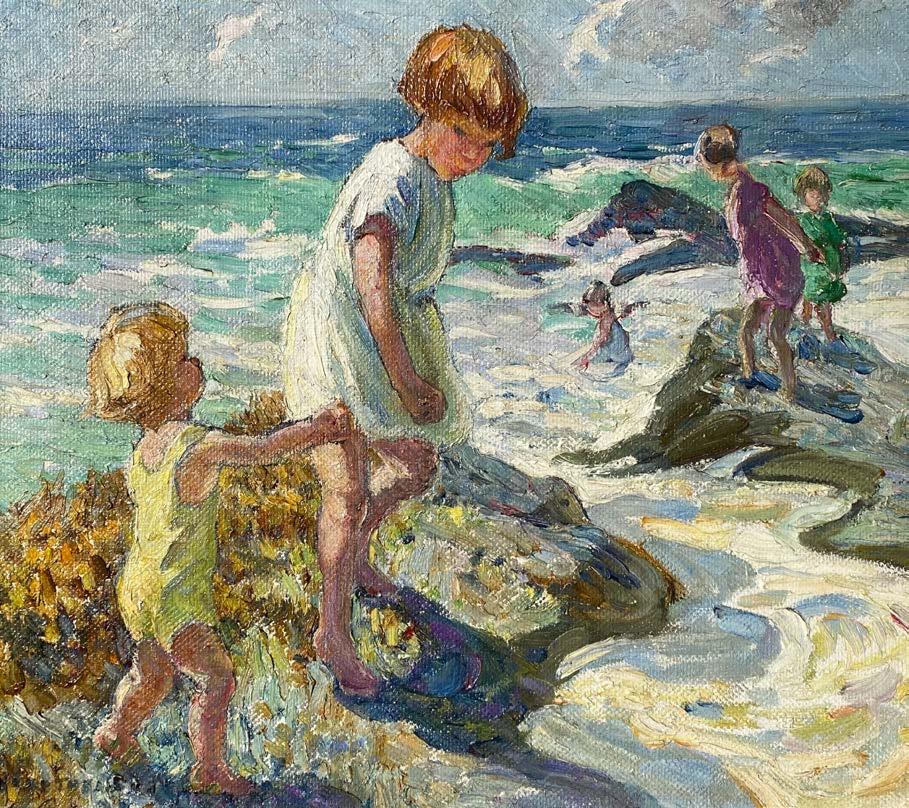
Dorothea Sharp
British, (1874-1955)
Inspired by the picturesque coastal landscape of St Ives, Dorothea Sharps’ lively and vibrant beach scenes painted with spontaneous brush strokes of glowing colours brought her to the forefront of British artistic circles. Her charming depiction of children playing on the sand at the water’s edge have in recent years become her most celebrated works, whilst her eloquent still lives are widely collected.
Sharp studied at the Art School in Richmond under Charles Edward Johnson, and at the Regent Street Polytechnic working under Sir David Murray and George Clausen, and later studied in Paris.
During a visit to Paris in 1900, Sharp saw first-hand the work of the Impressionists, which had a profound and lasting effect on her work. Not only was she influenced by the work of the Impressionists, she also came to know and love the work of some of the American painters who were in Paris at the same time. Notably, Frank Benson (1862-1951) and Carl Frieseke (1874-1939).
In the 1920s and 1930s, Sharp travelled widely in Europe, visiting the South of France, Italy, Spain and Portugal. She worked within the tradition of the French Impressionists, and similarities with Monet can be seen in her treatment of light and colour. During her regular summer visits to St. Ives in the 1920s, she began depicting playful scenes of children, often playing on the beach. Sharp’s charming depictions of children are now her most celebrated works. Spontaneous brushstrokes, the use of glowing colours, and the clarity of light define her as a significant figure in twentieth century British painting.
Summer Rockpools
Oil on Canvas
37 x 47 cms / 14½” x 18½”
Provenance
Private Collection, UK.
Gladwell & Patterson, London; acquired from the above in 2021.
89
Pablo Picasso Spanish (1881–1973)
"It is Jacqueline’s images that dominates Picasso’s work from 1954 until his death, longer than any of the women who preceded her. It is her body that we are able to explore more exhaustively and more intimately than any other body in the history of art."
Jacqueline au Bandeau
Conceived in 1962, Cast in bronze in 1964
Bronze relief sculpture cast from a linocut
34.6 x 26.6 cms /13½” x 10½”
Stamped with the foundry mark ‘E. GodArd Fondr Paris’
Unnumbered edition of 2
Provenance
Estate of the Artist
Marina Picasso, the artist’s granddaughter; acquired from the above.
Gladwell & Patterson, London; acquired from the above in 2022.
Claude Picasso has confirmed the authenticity of this work.
90
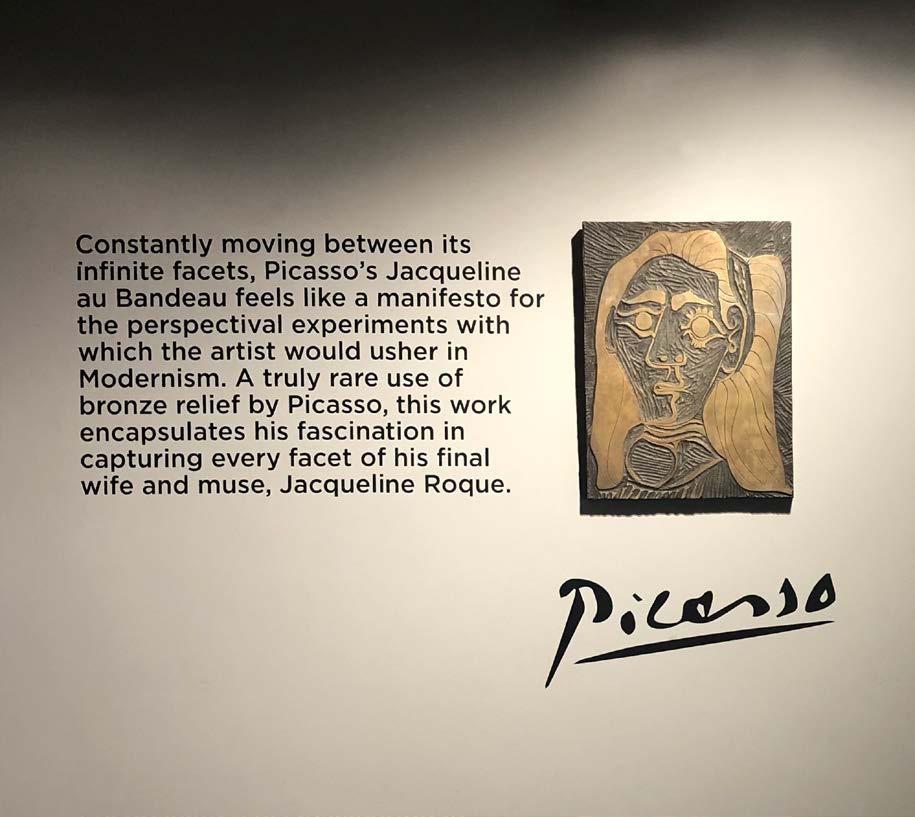
91

92
Pablo Picasso’s Jacqueline au Bandeau encapsulates the startling vitality of the artist’s late period, memorialising not only the expressive style which he pioneered; but also his reinvention of the possibilities of printmaking. Picasso commissioned this bronze relief in 1964, of an original linocut entitled Femme au Cheveux Flous, which he created two years prior, as a unique encapsulation of one of his most accomplished print series. Cherished first by Picasso and then his descendants for nearly sixty years, we are proud to present this distinctive work to the public for the first time.
Following his marriage to Jacqueline Roque in 1961, Picasso would embark upon a period of intense experimentation and production, which would characterise his final decade. In these years, the great artist focused his gaze upon subjects he considered to be pure archetypes; foremost amongst these were the face of his muse, Jacqueline.


Picasso always experienced bursts of creative energy when in love, and Jacqueline au Bandeau was conceived in 1962 only shortly after his marriage, one of a group of portraits testifying to his intensity of feeling. More than simple representations, Picasso composed his portraits of Jacqueline from memory, creating some of his most personal and subjective interpretations of the human character.
Yet beyond its striking visuals, Jacqueline au Bandeau stands as a near-unique material record of Picasso’s revolutionary impact on the print medium. In the early 1960s, Picasso would pioneer the reductive method of producing linocuts, greatly expanding the technical possibilities it afforded artists.
Aware of his achievement, Picasso chose to memorialise a small selection his best linocuts in bronze, transforming them into accomplished relief sculptures in their own right. Each line and groove of Jacqueline au Bandeau therefore represents a rare physical imprint of Picasso’s hand as he worked and reworked the printing block. A testament to both stylistic and technical innovation, Picasso’s bronze relief offers the viewer an outstanding opportunity to experience a direct material connection to his genius.
93

Pablo Picasso
Spanish (1881–1973)
La Serrure
Knitted Wool Tapestry
Designed and Created in 1955
205 x 150 cms / 81” x 59”
Signed ‘Picasso’
Provenance
Commissioned by Marie Cuttoli.
Lucie Weill Gallery.
Private Collection; France.
Gladwell & Patterson, London; acquired in 2022.
Claude Picasso has confirmed the authenticity of this work.
95
Out of all of Picasso’s unrivalled contributions to twentieth century culture, his successes in elevating decorative media to the status of a fine art is perhaps his most significant legacy. From collage, to ceramics, to printmaking, he continually sought to expand the material language of art; yet the field upon which he had the greatest impact were tapestries and textiles. La Serrure , a knitted wool tapestry designed by the artist and made in 1955, thus stands as an encapsulation of his achievement.
La Serrure was commissioned in 1955 by Marie Cuttoli, a French designer instrumental in the resurgence of twentieth-century tapestry. Cuttoli had, from the 1930s, enlisted a range of artists (including Miró, Man Ray, Leger, Braque and Picasso) to support her project of rescuing the status of textile art. The importance and extent of her contribution is the subject of numerous exhibitions and studies to this day.
The design process involved Picasso creating a cartoon, a to-scale design on cardboard, which was then sent to weavers for manufacture. Throughout the creation of the final tapestry, Picasso periodically checked the unfinished work to ensure its quality was at the highest standard and it was being made according to his plans.
La Serrure is unique amongst Picasso’s woven creations for its use of an original composition. Picasso’s tapestries were often produced as reinterpretations and reproductions of his canvases, most famously in the case of Picasso’s monumental Guernica of 1937, which hung outside the chambers of the Security Council of the UN. There is no painted precedent for La Serrure The textile thus stands as an artwork in its own right.
Translated as ‘The Lock’, La Serrure is a fine example of Picasso’s confidence in translating his style across media. Intended to be used as a carpet, the image of a figure appearing through a keyhole alludes to the domestic setting implied by the artwork in a way rarely attempted by Picasso. The motif of the dove in the upper left corner, outlined in both black and green plays homage to the recurring motif of La Colombe that Picasso incorporates into his work throughout his oeuvre. Standing as a symbol of peace, its presence in the domestic setting is a deeply personal motif for Picasso, who adored animals, and allowed them to run freely around his house and studio. The vibrant colours of red and green with the lineal outlines of the subject in black are juxtaposed against the cream background, revealing Picasso’s confident approach to interior furnishings.
96
Pablo Picasso studying a tapestry in Cannes, 1959
Photograph by Edward Quinn Musee National Picasso-Paris
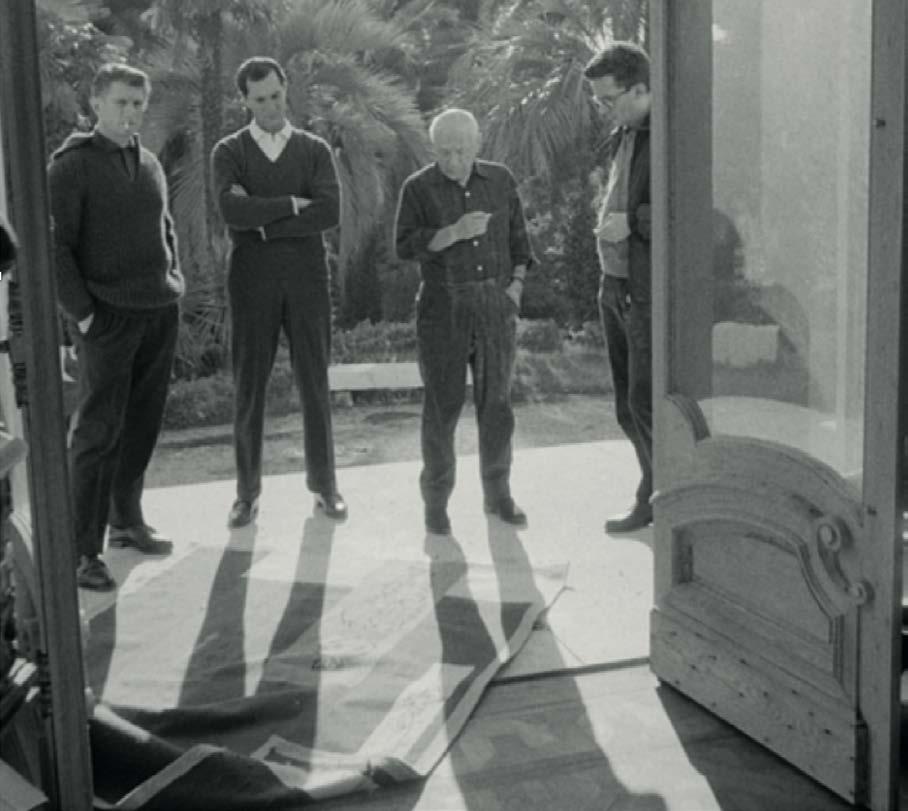
Georges Bauquier
French, (1910-1997)

Nature Morte aux Deux Pommes, No. 5
Oil on Canvas
92 x 73 cms / 36” x 29”
Provenance
Studio of Georges Bauquier, France.
Private Collection, France; acquired from the above.
Gladwell & Patterson, London; acquired in March 2022.
Exhibitions
Cannes, La Malmaison, Georges Bauquier : Natures Mortes à la Fenêtre, December 2002 – February 2003, (reproduced on page 53 of the catalogue.
Vascoeuil, Château de Vascoeuil, Georges Bauquier 1910 – 1997 : Paintings – Gouaches – Drawings, March to June 2005.
98
Bauquier’s Nature Morte aux Deux Pommes, No. 5 was painted in the middle of the artist’s mature phase. One of a series of still lifes, all of which bear an identical title, the paintings in this series all reiterate similar motifs; two apples positioned on top of a gathered table cloth within a striking interior backdrop. Vibrant wall paper, as in the present work features heavily throughout this series adding to the depth and drama of each composition.
Larger in size than most of the painter’s output, Bauquier clearly saw these pieces as emblematic of his style. Strongly structured and vividly coloured, the artist balances his cubist roots with his personal love of expressive colouration. From the beginning of the 1960s, when Bauquier had begun to truly move out of Léger’s shadow, his work had begun to assume the characteristics we find in Nature Morte aux Deux Pommes, No. 5 ; an interior still life spread across large surfaces of colour.
Nature Morte aux Deux Pommes, No. 5 is most interesting for its return to a central motif for the painter: foliage. Many of the artist’s earliest works concern themselves with plants and trees reaching outwards and spreading their leaves, an analogy to his growing artistic independence, yet as the artist more confidently adopted his own style of still lives these vignettes began to disappear. Nature Morte aux Deux Pommes, No. 5 therefore represents a far more biographical composition than is commonly seen in his work: synthesising his personal late style with a memory of his early years working with Léger.

99
Georges Bauquier in his studio
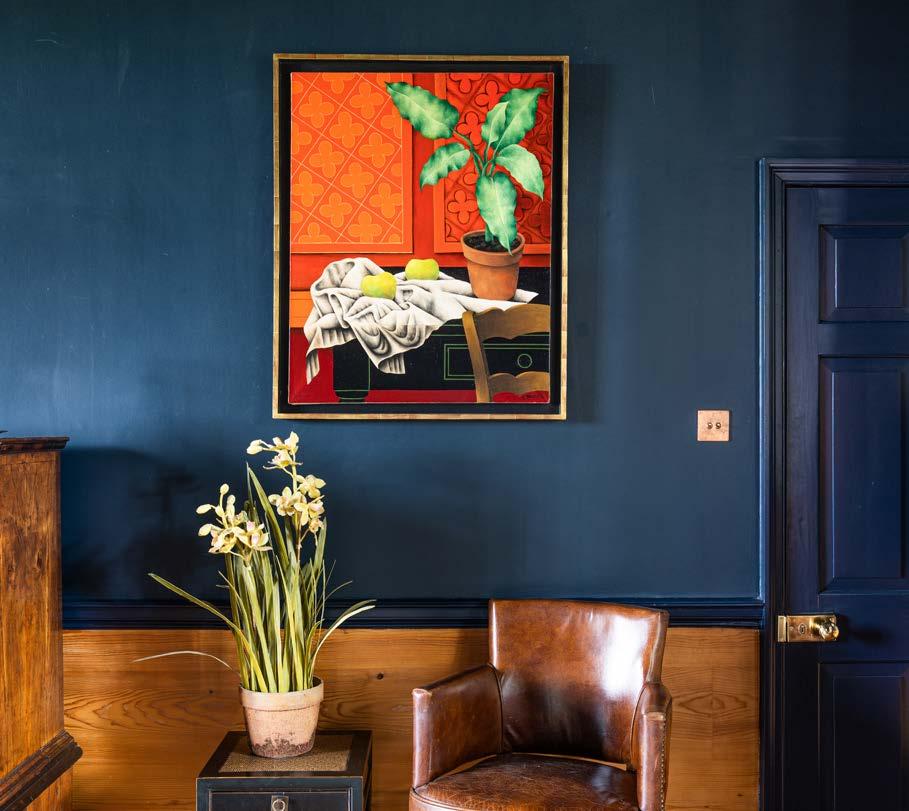
100
Georges Bauquier French, (1910-1997)
Georges Bauquier’s career is defined by his intimate, personal and professional relationship with the great Cubist master, Fernand Léger. For twenty years, the two painters worked closely together; and after Léger’s death, Bauquier would be instrumental in both founding a museum dedicated to the artist and writing his eight volume Catalogue Raisonné.
Crucially, despite effectively remaining in Léger’s shadow until the older painter’s death in 1955, Bauquier was able to create his own synthesis of Cubism, creating a personal style that combined Léger, Braque and Cézanne, for which he is increasingly lauded.
As the French critic Tabaraud notes:
“It cannot appear easy to be, for the twenty years from 1936 to his death, both the friend and closest daily collaborator of Fernand Léger and still pursue autonomous pictorial research, yet through constant study in the secrecy of the studio, Bauquier was still able to find a personal identity.”
Born in 1910 in Nîmes, Bauquier would decide to become an artist in his early twenties, enrolling the School of Fine Arts in Paris in 1934, where received a first-rate classical education in draughtsmanship. However, after becoming increasingly dissatisfied at the constraints of academic painting, Bauquier would join the School of Contemporary Art in 1936, where he immediately began to work closely under, Fernand Léger, who was the School’s director.
During the Second World War, where the young artist joined the Communist Party and French Resistance, which culminated in a period of imprisonment by Nazi occupiers. Upon release, he reunited with Léger. During the following decade, the two artists would work together daily; so close was Bauquier’s relationship with Léger, that after the latter’s death in 1955, he married Léger’s widow, Nadia. Alongside his wife, Bauquier immediately set about creating a museum to celebrate Léger’s life, which they opened in 1960 and would subsequently furnish with 348 works by Léger.
Bauquier’s personal style would develop quickly, and while he often declined to publicise his output, his exhibitions in the early 1950s were prefaced by Léger and saw great success in Paris. His works are usually predicated on a balance between great colouristic freedom and maintaining rigid compositional principles which he had learned from his teacher. Bauquier’s best known pieces are his still lifes, which occupy bold, often Cubist-inspired interiors, and frequently feature the artist’s favoured motif, a single piece of vegetation.
101
Georges Terzian
French, (Contemporary)
The title of the canvas, Cache Cache , translates as hide-and-seek: an apt description for the cubist style which features so heavily in the work. Terzian presents the viewer with a complex combination of geometry and texture, in which they are invited to find hidden forms and shapes. Terzian is particularly known for his experiments with the formation of different objects, often breaking down his subjects into purely abstract components, and Cache Cache stands as one of the artist’s most abstract pieces. With its sharp pointed lines, diverse colours and complex textures, this canvas by Terzian is therefore a perfect encapsulation of the lineage of cubist and constructivist techniques he so successfully emulated.
Cache Cache is typical of Terzian’s work in the 1980s. Where his earlier paintings were often figurative or based on landscapes, and his later works evoke a sculptural prototype, delineating a single abstract solid, this middle period is perhaps the closest the artist came to a pure cubist style. At the same time, Terzian’s main inspiration moved away from Cézanne and towards Picasso, Braque and Leger, his paintings becoming increasingly colourful. This period would also see the artist incorporating Russian constructivist practices into his compositions, bringing a linear straightness to previously sinuous lines.
Cache Cache
Oil on Canvas
50 x 73 cms / 19¾” x 28¾”
Provenance
Private Collection, France.
Gladwell & Patterson, London ; acquired in July 2022.
102
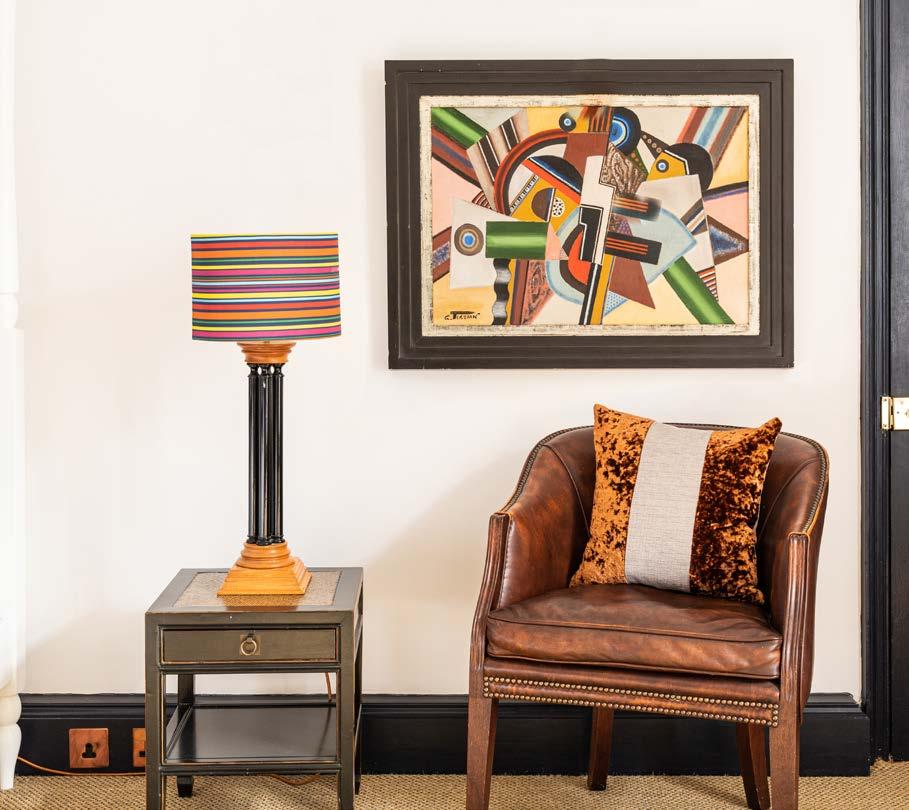
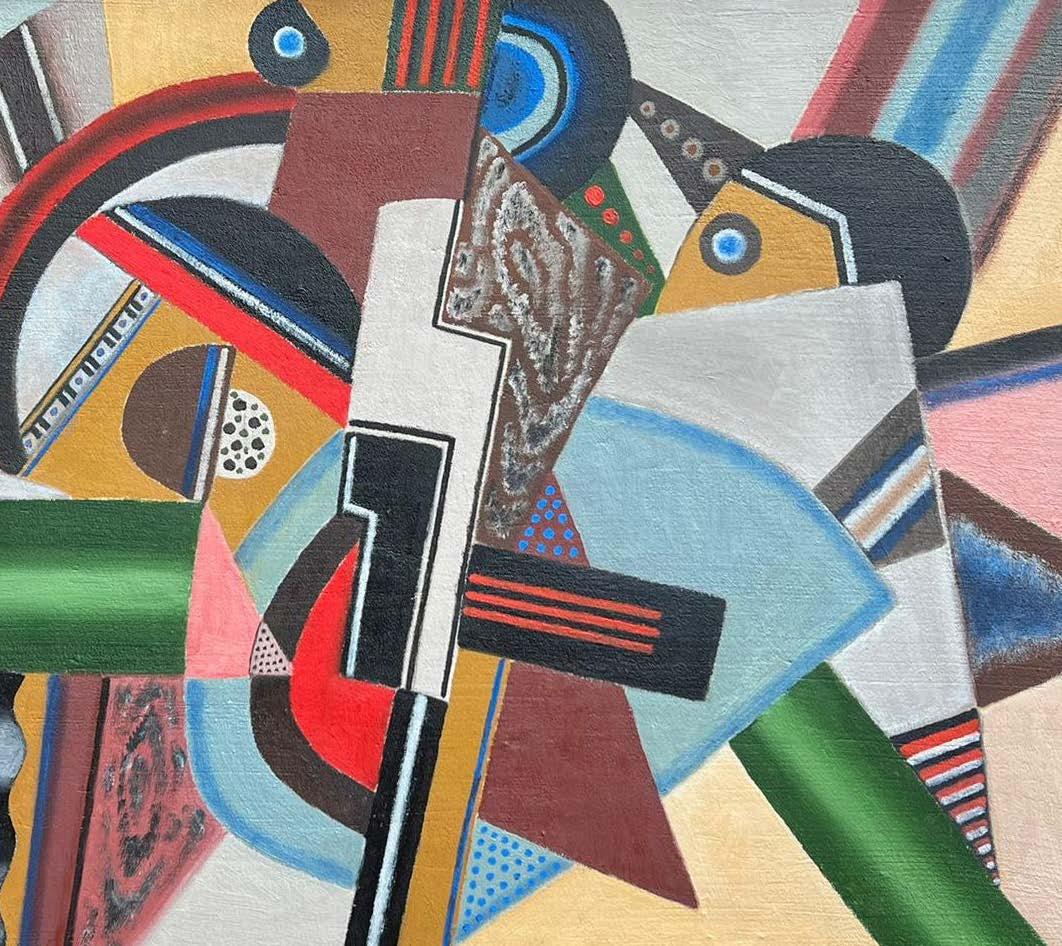
Georges Terzian
French, (Contemporary)
George Terzian is a French Postwar & Contemporary painter known for his vibrant, abstract and geometric compositions. Terzian moved to Paris in the 1960s, and became a cabaret singer which enabled him to pursue his passion for painting. There he would turn to the cubist style for which he is celebrated, forming a synthesis of Picasso, Braque and Leger’s early work in his unique, post-cubist style.
Terzian's work is heavily influenced by the geometric abstraction movement, which emerged in the early twentieth century and emphasizes the use of geometric shapes and forms to create abstract compositions. His paintings are characterized by their precise and clean lines, bold colors, and geometric shapes. He often uses a limited palette of colors, such as black and white, to create a sense of harmony and balance in his compositions.
Terzian was born in Marseille in 1939, to parents of Armenian descent. His family had left their homeland for Russia at the start of the twentieth century, although they would then settle in France shortly before the artist’s birth. Georges took an early interest in drawing and painting, and his parents therefore encouraged him to join the Ecole des Beaux-Arts in Marseilles at the age of fourteen. From a studio in Sainte-Miter, he would experiment with impressionist techniques en plein air in the Provençal countryside, working in gouache and oils in a manner reminiscent of Cèzanne, continually honing his technique.
Yet Terzian was clearly a man with an eclectic taste which ran beyond his skill as an artist. In the midst of his studies in art school, Terzian discovered a love of boot making, which prompted him to interrupt his education for over a year while he studied the craft. When he moved to Paris at the age of twenty, he also elected to study music, and took lessons from the famous singer Jean Lumière. In fact, while his style began to transition towards cubism in the early 1960s, it was his job as a cabaret singer which would support the young artist financially. It is easy to see Terzian’s polymathic nature in his mature paintings, which draw from a wide range of styles and cultures to create their inimitable modernist feel. His musical studies in particular bring a symphonic, lyrical quality to his works reminiscent of artists such as Kandinsky.
The influence of the work of Picasso, Braque and Leger remains constant throughout his oeuvre, while maintaining a personal style. His iconography also draws on the North African cultures that he interacted with during his many stays in Africa, alongside Russian constructivist motifs from his time living in Moscow.
Throughout his career, Terzian has had numerous solo and group exhibitions in France and internationally, and he continues to paint from his studio in Paris. Following a one-man exhibition of his work at the Parisian Giovanni gallery in 2007, his works have become increasingly wellknown on the international stage. The public interest in his works has also led to his much rarer early works gaining a particular popularity.
105
david leverett
British, (1938-2020)
Composition No. 2

Numbered ‘2’ (along top edge)
Gouache and Pencil on Card
55 x 80 cms / 21” x 31"
Provenance
Estate of the Artist. Gladwell & Patterson, London; acquired from the above in 2022.
106
david leverett
British, (1938-2020)
Composition No. 7
Numbered ‘7’ (along top edge) Gouache and Pencil on Card 55 x 80 cms / 21” x 31"
Provenance Estate of the Artist. Gladwell & Patterson, London; acquired from the above in 2022.

107
David Leverett’s abstract paintings are emblematic of the avant-garde 1960s British art scene. With their large scale and irregularly shaped geometry, executed in vivid acrylics, Leverett’s paintings burst with vibrancy and dynamism.
Born in Nottingham in 1938, Leverett studied at Nottingham College of Arts in the late 1950s, where his early work demonstrated a predilection for bold, abstract forms. In 1961, he moved to London to complete his training with a further three years study at the Royal Academy, immersing himself in nascent movements of the 1960s, from Pop Art to Op Art. Upon graduation, Leverett began exhibiting almost immediately with a series of shows at the Redfern Gallery, followed by one man shows at the John Moores Liverpool Exhibition in 1967 and the Whitechapel Art Gallery in 1968. In the same year, still only thirty, his work was included at the Royal Academy Bicentenary Exhibition.
Leverett’s landscapes have enormous vitality. Preoccupied with the natural world, his compositions seek to combine the elements of water, air, sky, and earth which are always in a state of change and motion. Leverett abstracts and distorts the landscape, giving viewers the opportunity to travel in their imagination as they choose.
In his later years, he would begin to pull back slightly from abstraction, producing bold landscapes that reflect a growing concern with environmental causes. While he was perhaps best known for the geometric work he produced in the sixties, he continued to remain an important force in British art, winning the inaugural Sargant fellowship at the British School in Rome in 1990.
Alongside his painting, David was for many years a leading teacher at the Slade School of Fine Art, a role for which he is fondly remembered by numerous students. Education was clearly a passion of his, and in addition to his work at the Slade, David would often travel internationally to give workshops. David passed away in 2020, at his Kentish Town home after a career of over fifty years. During that time his work had been shown around the world, from Venice to New York and today his paintings are in multiple museum collections, most importantly at Tate Modern in London.
108
david leverett British, (1938-2020)
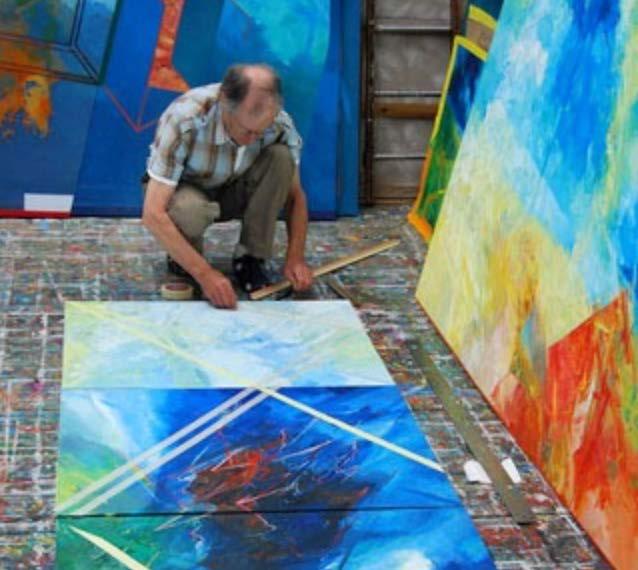
Donald Hamilton Fraser
British, (1929-2009)

“The West Coast of Scotland and the Highlands are the last wilderness in Britain, the last place where you feel alone with the landscape around you. You have a sense of being the only person alive on the planet; it awakens emotions that one didn’t know were there. I like that feeling because there is nothing to impede your reaction, it’s just you and the sand, you and the tide.”
Oil on Paper
23 x 30 cms / 9” x 12”
110
Faraid Head IV
Provenance Private Collection, UK. Gladwell & Patterson, London; acquired from the above in 2022.
- Donald Hamilton Fraser

111
Boats on the Foreshore, Portskerra

Oil on Paper
39 x 58 cms / 15½" x 22¾"
Provenance Private Collection, UK.
Gladwell & Patterson, London; acquired from the above in 2021.
112
Donald Hamilton Fraser
British, (1929-2009)
Donald Hamilton Fraser is a highly acclaimed British painter. Fraser dramatised his subjects with bold colours and a confident brush. His work employs a language of visual metaphor in which abstract and descriptive elements combine to express a heightened experience of the subject.
Inspired by the Scottish Highlands of his ancestors, Fraser depicted the rugged landscape like no other artist. Captured in all its myriad guises, according to the fleeting effects of light and atmosphere, he transformed the Highland landscape into vivid swathes of colour.
Fraser was a master at capturing an array of subjects, from the natural landscape to vibrant still lives. He adored the expressive nature of paint and the striking juxtaposition of primary colours, often layering them onto the canvas with a palette knife to produce an almost collage-like effect. Under his deft brush, the tradition of landscape painting is distorted to form abstract almost dream-like fields of colour.
Fraser was born in London to Scottish parents. His father was an antiques dealer, and Fraser’s childhood was spent surrounded by beautiful objects and art. Fraser developed a keen interest in literature, reading voraciously and writing poetry, and he began to train as a journalist with Kemsley Newspapers before completing a period of national service in the Royal Air Force in the late 1940s.
Fraser studied at the prestigious St. Martin's School of Art from 1949 to 1952 alongside notable contemporaries including Jack Smith, Leon Kossoff, Frank Auerbach and his close friend, Peter Kinley. For many young artists in the early 1950s, they felt a need to become either an abstract or a figurative artist. Fraser did not feel these had to be mutually exclusive, and an exhibition of the work of Nicolas de Staël at Matthiesson's on Bond Street in 1952 acted as catalyst to reconcile these two styles within his work.
Over the course of his career, Fraser had frequent one man exhibitions at Gimpel Fils in London and Paul Rosenberg Gallery in New York. From 1958 to 1983, Fraser taught at the Royal College of Art. During this fellowship, he taught many notable young artists that would go on to be leading figures of their generation, including David Hockney, Ronald Brooks Kitaj, Patrick Caulfield and Thesese Oulton. Fraser became a Fellow of the Royal College of Art in 1970 and was elected as a member of the Royal Academy in 1975. In Fraser’s later years, he received many private and public commissions and took part in frequent gallery exhibitions throughout Britain. Shortly before he passed away, two major retrospectives of his work were held in London at Arthur Ackerman and the CCA Galleries.
113
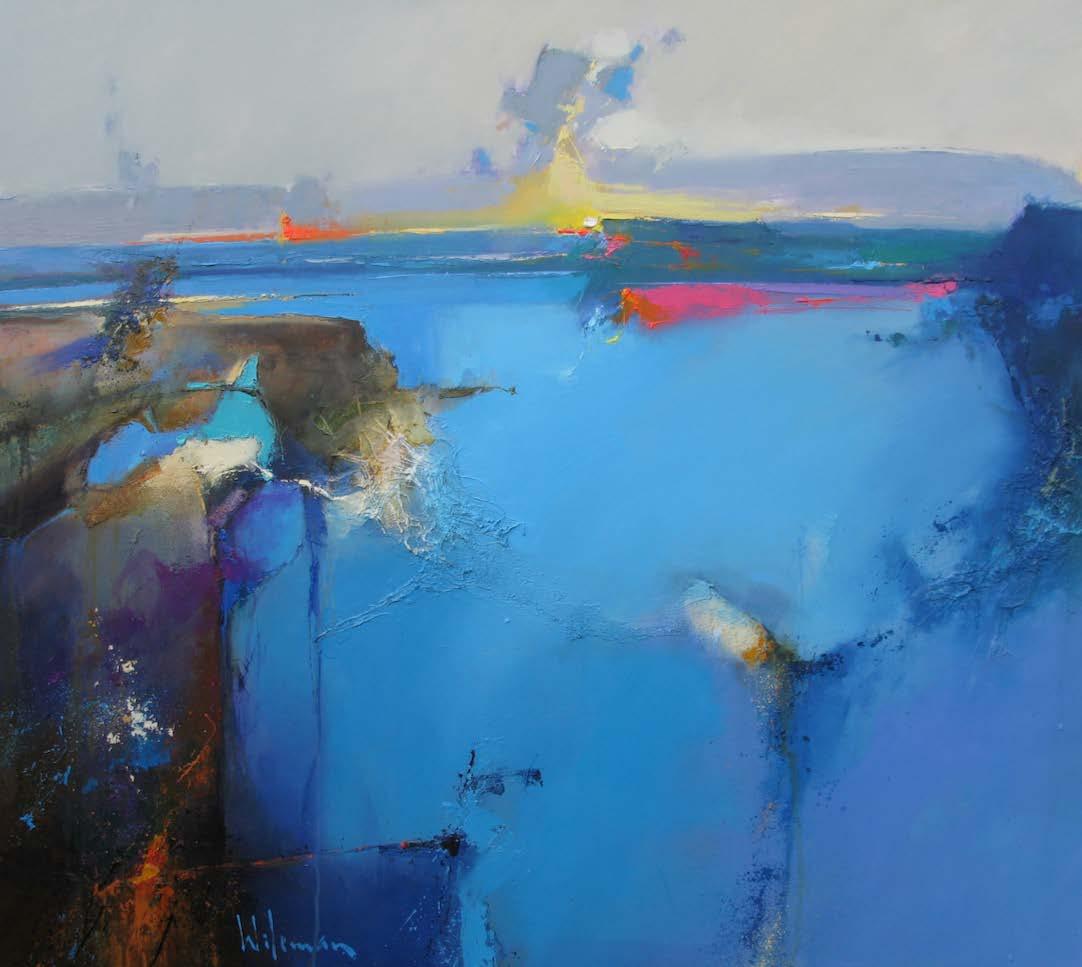
Peter Wileman
British, (Contemporary)
“For me, painting is as much a part of the day as eating and sleeping. In fact, it’s more important than that, more like breathing! I could not imagine a single day passing without talking about, reading about, or actually taking part in some kind of activity concerning art. Like a moth is drawn to a flame, a painter is drawn to the light, and although I have tried to express myself with painting in many different forms, mediums and styles over the years, my path has lead me inexorably, like so many others before me, to try and capture that elusive quality of light, that only a shimmering sunset, dawn of a new day, dazzling sparkle of reflection off both sea and river presents to one who is prepared to both look and see.”
- - Peter Wileman

115
Twilight Intensity Oil on Canvas 90 x 120 cms / 35½” x 47¼”
Peter Wileman
British, (Contemporary)
Across the Bar
Oil on Canvas
40 x 40 cms / 15¾" x 15¾"
Highly acclaimed British abstract artist Peter Wileman is one of the UK’s leading contemporary landscape artists today. Known for his dazzling abstracted oil landscapes, Wileman’s style is bold and vigorous, both in the use of colour and handling of paint, as he explores the effect of light on his subject. Seeking atmosphere through light and colour, he works in varying degrees of abstraction.
Interested in painting from a young age, upon leaving school he went straight into his first job at Hallmark Cards, a card company, where his innate artistic talent was immediately recognised. Here Peter spent five years studying lettering and design, his first artistic training - which gave him a solid grounding in colour awareness and formal structure. Wileman later became the art editor on a number of magazines. Looking for an opportunity to develop his own artwork, Peter left his budding design career to become a freelance artist; a decision from which he has never looked back.

116
Peter Wileman

British, (Contemporary)
Wileman’s style is bold and vigorous, both in the use of colour and handling of paint, as he explores the effect of light on his subject. Working exclusively in oils, the medium most adaptable to changes of light and mood, he evokes atmosphere through light and colour through varying degrees of abstraction. Wileman’s work is reminiscent of the great master Joseph Mallord William Turner through its atmospheric quality. His work has a superb energy, with paint applied in washes and also with areas of impasto. The foregrounds are complex, but not disctracting to the subject within his work.
Over the last two decades, Wileman has exhibited regularly at a number of prestigious art venues including the Royal Society of Marine Artists, the New England Art Club and the Royal Institute of Oil Painters of which he is an associate member. Wileman has built a distinguished reputation as one of the finest landscape artists practising in the UK today.
117
Hymn to the Dawn
Oil on Canvas
40 x 40 cms / 15¾" x 15¾"

118
April Haze, No. 3
Painted in 1957
Oil on Canvas
43 x 109 cms / 17” x 43”
Ivon Hitchens CBE
British, (1893-1979)
Provenance
The artist’s studio.
Kenneth Webb, UK; acquired from the artist in the 1970s.
119
Ivon Hitchens CBE British, (1893-1979)
Beyond his great importance to twentieth century British painting, Ivon Hitchens holds added significance for Gladwell & Patterson for the influence he would have on one our leading painters, Kenneth Webb. Webb has admired the work of Ivon Hitchens since the early years of his studies, and his influence can be seen throughout the younger artist’s work, particularly his Field Poppies and Myths and Legends series. The two first met at Hitchens’ 80th birthday in 1973, where they formed an immediate friendship. Both artists would often meet and share their technical experience and insights. Thus, while Hitchens was a significant visual source of Webb’s aesthetics, it would be the younger artist who introduced Hitchens to the experimental effects which could be achieved through the use of acrylic paints.
Sitting in a liminal space between the binary of abstract and figurative painting, both artists applied elements of these two stylistic poles in their respective quests to capture their immediate surroundings and create a new form of expressive landscape. As the critic Patrick Heron put it in the mid-1950s ‘Hitchens in West Sussex provides the most distinguished example of profound personal identification of a painter with a special place or landscape’. While Hitchens may have moved close to abstraction, his immersion in his beloved West Sussex environment would always ground his work in a very real topography. The close perspectives and solid planes of colour found in his landscapes evoke the sense of an artist submerged in the woods and ponds around his Petworth home. It is this attachment to their surroundings that most clearly unites Kenneth and Ivon.
It is therefore of particular significance that both the present works, April Haze no. 3 and Wildflower Wood , have been a part of Kenneth Webb’s personal collection. As such, they not only symbolise the shared artistic development of the two artists, but offer a physical reminder of how the journey of artworks between collections can serve to add greater meaning to the paintings themselves. That Kenneth Webb, one of Hitchens’ greatest admirers, choose these two examples of the older artist’s works is the clearest testimony as to their importance as paradigms of his style.
120


122
Wildflower Wood
Painted in 1975
Oil on Canvas
40.5 x 74 cms / 16” x 29”
Ivon Hitchens CBE
British, (1893-1979)
Provenance
The artist’s studio.
Waddington Galleries Ltd., London.
Kenneth Webb, UK; acquired from the above in the 1970s.
123

124
Ivon Hitchens CBE
British, (1893-1979)
Wildflower Wood was acquired soon after it left Hitchens’ studio in the mid 1970s. With its bold greens, pinks and blues, the work bears testament to its painter’s continual development well into his eighties and may well allude to the reciprocal influence that Kenneth Webb’s bright colouring had on the older artist. In contrast, April Haze no. 3 was created during Hitchens’ most celebrated phase as an artist, between representing Britain at the 1956 Venice Biennale alongside Lynn Chadwick and receiving his CBE in 1958.
The doorway to Hitchen’s studio is depicted to the left, surrounded by trees, which emerge out of a panoramic sweep which at first glance appears abstract, an effect emblematic of Hitchens’ entire style. Ivon Hitchens would keep this painting in his studio for well over a decade, until Webb acquired it in the early 1970s. These two works, which have been in Webb’s collection for nearly fifty years, are thus brilliant examples of both artist’s shared goals in colouring and abstraction.
A final consequence of the journey from one artist’s studio to another is the often-forgotten element of a painting’s framing. Hitchens was famously specific about how his works should be framed, specifying that they should remain in the wide-bordered, pale wooden settings that he himself designed. Unfortunately, after his passing, many galleries and owners sought to change these frames to fit ever-changing contemporary tastes, decisions which have resulted in the loss of a great number of these integral parts of the artwork. Yet, precisely because April Haze and Wildflower Wood passed directly from the artist to a close friend, both of their frames have remained in excellent condition. To this day, their survival helps to contextualise and inform the artworks they hold, just as Hitchens intended them to.
These paintings are therefore wonderful examples of the importance that the provenance and journey can have on how we see artworks. Taken independently of their history, these paintings are rich evocations of the power of Hitchens’ craft from his mature to his late phase. Yet it is the addition of their journeys that serves to magnify and enrich their importance and meaning. Not only do both paintings testify to the symbiotic relationship shared by Hitchens and his most important follower, Kenneth Webb, but their direct passing between these artists serves to illustrate important themes of preservation and the common goals of both figures.
125
Kenneth Webb
Irish, (Contemporary)
Kenneth Webb is considered to be one of the finest landscape painters of the last one-hundred years. Over the course of his career, Kenneth’s landscape painting has evolved through several significant phases over his many decades of painting - in terms of both subject and technique, and today he continues to create and innovate through his art.
Kenneth has spent his life creating spectacular paintings so that we might share his own individual reaction and impression to the natural world around us. Kenneth’s paintings are an exploration and celebration of the natural world through colour. Experimenting with colour in a free, expressionist manner since his art school years, Kenneth has arrived at a joyous aesthetic that captivates and envelops the viewer. Taking inspiration from the natural landscape around him, from his garden and his studio in Connemara on the west coast of Ireland, his paintings are rooted in place and are deeply personal.
From vibrant, attention grabbing, poppies to ethereal waterlilies, Kenneth has always sought out the beauty in the natural world that surrounds him. From the south coast of Devon to the rugged landscape of Connemara, Kenneth’s artistic milieu has enabled him to constantly evolve and reimagine his subjects.
Despite their range, none of these themes has been entirely isolated or completed; Kenneth continually revisits subjects and techniques, adapting his approach and combining ideas in his eternal quest to truly capture the mood, the emotion - the spiritual essence - of a landscape.
Over the course of Kenneth’s lengthy artistic career, he has shown works at numerous notable institutions, including the Royal Academy in London. Kenneth founded the Irish School of Landscape painting in 1957, and has since lectured at the Tate Gallery, Victoria and Albert Museum and the National Gallery in London.
Kenneth’s paintings are celebrated and collected internationally, with his work placed in prestigious collections across the world. Gladwell & Patterson have represented Kenneth Webb in London since 2010 and in that time his monumental works have found fame with important collectors in China, America and the United Kingdom.
126

127
Summer Poppies
Oil on Canvas
53.5 x 63.5 cms / 21" x 25"

128
Clarissa James
Austrian, (Contemporary)
Inspired by Edward Burne-Jones and the Pre-Raphelites, Clarissa James is a classically trained artist with an interest in both the Renaissance and nineteenth century techniques of realistic representation.
Clarissa’s love for drawing and painting was first inspired by a visit to the Watts Gallery near Guildford, an artists’ village dedicated to the work of the Victorian era painter and sculptor George Frederic Watts. She followed this initial impulse by researching drawing techniques in the London museums, where she became particularly interested by the the Pre-Raphelites, and pursued an anatomy course at the University College London Medical School.
In 1997, Clarissa moved to Florence to train at the prestigious Florence Academy of Art, an art teaching institution renowned for its commitment to the academic tradition. From there she went on to spend several summers at the studio of renowned Norwegian painter Odd Nerdrum and has since taught both Renaissance and nineteenth-century drawing techniques and the highly skilful technique of silverpoint drawing.
Clarissa is renowned for her life-size figurative works, which depict contemplative figures, often self-portraits, deep in thought or meditative states of mind. Her mesmerizing paintings of birds, peacocks, cranes and falcons, depicted against opulent hues of gold or silver, reveal the nineteenth-century aesthetic influences on her work.
Clarissa is drawn to silence and contemplation, and following a trip to the Far East she developed a great interest in the simplicity and clarity of Japanese art and design. This combined with her lifelong passions for fabrics, opulent textures and nineteenth-century aesthetic, results in unique paintings which are rich, meditative and calm.
Specific in her craft as an artist, Clarissa grinds her own paints to achieve a more unusual luminosity and texture. Her immaculate use of gold leaf brings a spiritual nature to her work and often her elaborate depictions of birds feathers and fabrics are embellished to create a tapestry or jewel like effect and bring a third-dimension into her oil paintings.
Spreading Wings Oil and Gold Leaf on Canvas
x 122 cms / 46” x 48”
117
129


Rising Oil and Gold Leaf on Canvas 117 x 122 cms / 46” x 48” 131
David Shepherd
British, (1931-2017)
“I find it hard to describe my feelings at that moment when I saw African elephants in the wild for the very first time. I had made childhood visits to zoos or circuses like other kids, but this was different. I was on my own two feet and there were two hundred elephants in front of me. Nevertheless, it was an exhilarating feeling. I don’t know whether I was afraid. I imagine not as it was all so new and exciting, and I wonder if even then I began to feel the affinity for these marvellous, gentle animals which was to develop so strongly. I know I will never forget the sight of those two hundred elephants browsing completely free and undisturbed. I felt so small, very small indeed. I was hooked forever.”
- David Shepherd
Elephants of Samburu Painted in 1964 Oil on Canvas 71 x 112 cms / 28” x 44” Provenance Private Collection, USA. Gladwell & Patterson, London; acquired in 2022.
132

133
Egrets and Friends
Painted in 2001
Oil on Canvas

40.5 x 76 cms / 16” x 30”
David Shepherd
British, (1931-2017)
Provenance
Private Collection, USA. Gladwell & Patterson, London; acquired in 2022.
134
Collection, USA. Gladwell & Patterson, London; acquired in 2022.

In the Midday Sun
Oil
23
9”
14”
135
Painted in 1994
on Canvas
x 35.5 cms /
x
Provenance Private
David Shepherd
British, (1931-2017)
Dusty Buffalo
Painted in 1967
Oil on Canvas
71 x 112 cms / 28" x 44"

Provenance
Private Collection, USA.
Gladwell & Patterson, London; acquired from the above in 2022.
136

137

138
December Morning, Cornwall
Painted circa 1913
Oil on canvas
51 x 61 cms / 20” x 24”
Sir Alfred James Munnings
British, (1878–1956)
Provenance
James C. Hardy Esq., Sixthorne Hall, near Norwich. Richard Green, London, until 1993.
Private Collection.
Sale; Christie's, New York, 1 December 2006, lot 97.
Private Collection, UK.
Gladwell & Patterson, London; acquired from the above in 2021.
Exhibited
Norwich, Castle Museum, Alfred Munnings, 1928, no. 124. Penzance, Penlee House Gallery & Museum, Munnings in Cornwall, 2019.
139
Sir Alfred James Munnings
British, (1878–1956)
Sir Alfred James Munnings is acclaimed as the greatest equestrian artist of the twentieth century, being recognized specifically for his energetic hunting and sporting scenes. He is equally celebrated for his very personal interpretations of the English landscape and as an exquisite portrait painter. A figurative painter who outwardly rejected Modernism, Munnings’ style and brushstrokes were influenced by Impressionism, using naturalistic colours to depict the English countryside and surrounding areas.
Painted whilst Munnings was living on the south peninsular of England, December Morning, Cornwall depicts a huntsman surrounded by his scampering, eager dogs trotting along the Cornish lanes in the crisp morning sun of a winter’s day. Munnings lived in Cornwall from 1910 to 1914, first at Newlyn and later in the small village of Lamorna, known for its wonderfully scenic cove. Munnings was struck by the beauty of the landscape in Cornwall. It was here that Munnings painted some of his finest landscapes. Concentrating on landscapes of the interior of the Cornish landscape rather than the more popular coast, Munnings continued to paint his favoured subjects of horses and hunting scenes, exploring the motif of a single majestic huntsman.
Munnings work of this period is classified by his desire to depict his subjects in sunlight in a direct, naturalistic way. In his later years his work became more concerned with the mood rather than the narrative, but the charm of Munnings’s early Cornwall paintings is ubiquitous. Over the course of Munnings time in Cornwall, his career was on the rise, evident by his first one-man exhibition at the Leicester Gallery in London in the spring of 1913. Shortly after this, the start of the First World War in 1914 put a decisive end to the ebullient artists’ circle in Cornwall.
Munnings captures the limitless rolling landscape of the area around Zennor in December Morning, Cornwall . The distant sea is visible upon the horizon and the deep, tree-lined valleys are painted in bold blocks of colour, while the horse and rider are lit up in the crisp, bright morning light. An active member of the Western Foxhounds at Zennor, this exquisite painting represents Munnings passion for riding, the hunt and also the beauty of the windswept Cornish landscape.
Celebrated as a great colourist, Munnings preferred painting outdoors in natural light, even on the coldest of days, only later working up his studies in the studio. Painting with a quick technique, Munnings applied his paint in sure, thick strokes achieving a densely textured surface, thus enlivening the scene despite the monochromatic palette of the English countryside. Munnings was the first painter to note that the coat of a living horse reflects the colours of the sky and its surroundings and it was this technique combined with the vigour of Munnings’s rich impasto brushwork that marks him out as the greatest equestrian artist of the twentieth century.
140
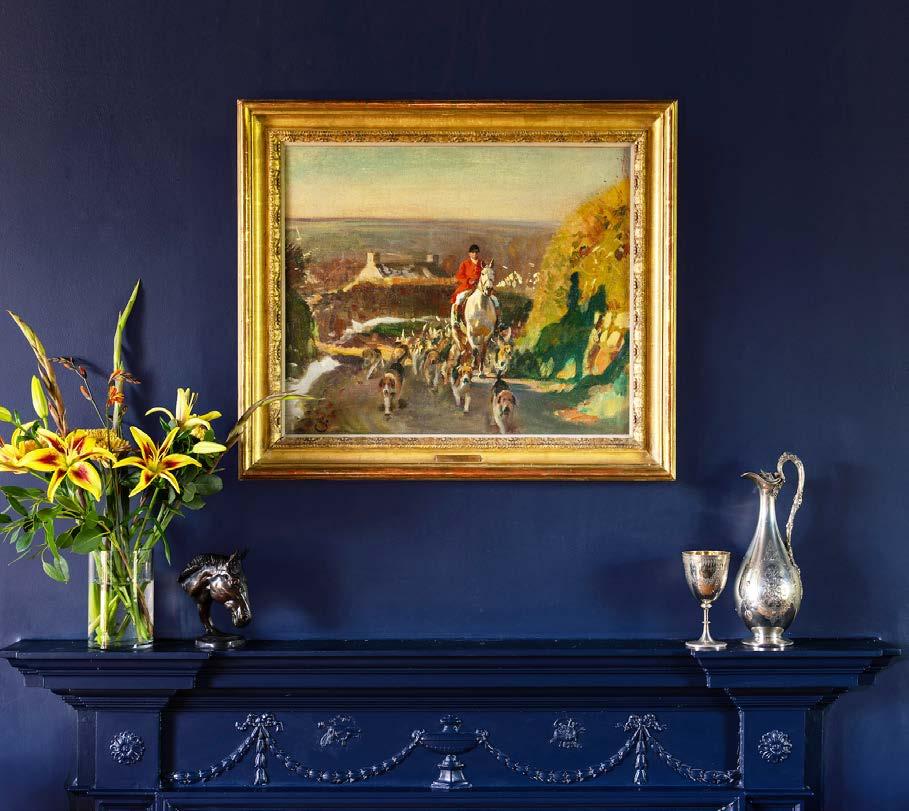
141

Grouse Morning
on Canvas
x 80 cms / 24" x 31½" 142
Grey
Oil
61
Paul S. Brown


Old Favourites Oil on Panel 20 x 60 cms / 8" x 24"
American, (Contemporary) Lining Them Up Oil on Canvasboard 18.5 x 18.5 cms / 7¼" x 7¼" 143
Paul S. Brown
American, (Contemporary)
A true Classical Realist, Paul upholds rigorous standards and holds firm to principles of artistic integrity, emulating the techniques and materials of the Old Masters. In a process he calls ‘Slow Art’ – referencing the Slow Food movement – he works from life in the naturalist tradition, paints on linen canvas and prepares his own paints by hand, carefully selecting pigments and oils to his precise requirements. Paul explains, “It’s a good foundation, to have the knowledge that you’re using the best pigment, bought at the mines and hand-ground yourself. When I pull out a tube of, say, yellow ochre, I know exactly where it come from and the journey I went through to go and get it. That gives a history to a painting, even at its early stages.”
Paul’s focus is on universal beauty, and in pursuit of this he enjoys painting all subjects, concentrating on the nude and still life but also producing portraits and landscapes. He is an exquisite draftsman, and his perfectly composed works are rich with atmosphere and detail.
Paul has an immeasurable talent for finding the beauty in all objects, be that a ball of twine and terracotta pots found in his garden shed or dusty vintage bottles of wine, ready to be poured as a delectable treat for a connoisseur.
Paul’s work is a rare combination of classical composition and exquisite colour and tone, made possible by his insistence on working exclusively from life and on using his own hand ground paints. These precise skills are particularly apparent in his figurative work. Paul considers figurative work as the pinnacle of artistic investigation. His nudes are painted with his characteristic restraint and elegance.
Paul’s still lifes always provide a visual banquet for the connoisseur of fine food and wine. Much of his work is deeply inspired by the flavours of produce that make their way onto his kitchen table and is often a celebration of the journey of farm and field to larder, cellar and kitchen. His still lifes breathe on the canvas; the shoots growing from onions, the daylight fading on a newly opened bottle of Bordeaux as a ripe brie oozes off a cheeseboard. Freshly harvested vegetables and a glorious abundance of foie gras and fowl provide an atmosphere of feasting to some works, whilst others become moments of pause and reflection – quiet glasses of the finest wine sipped in the afternoon sun with ripe slices of cheese.
Paul’s early training at the Florence Academy of Art, an art teaching institution renowned for its commitment to the academic tradition, in Italy, still resonates from his paintings today. There is a resolution of style through his careful scholarship and consideration of the French academic tradition, which uphold Paul’s worldwide reputation as a leading contemporary realist painter.
Après Dîner Oil on Canvas 51 x 56 cms / 20" x 22"
144
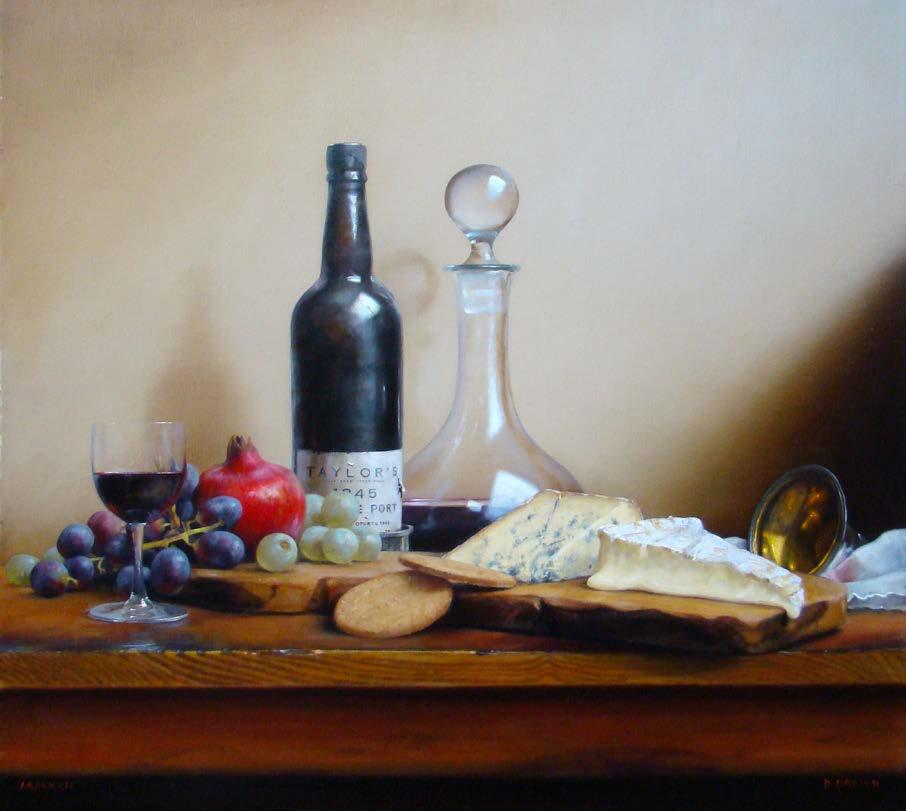
145
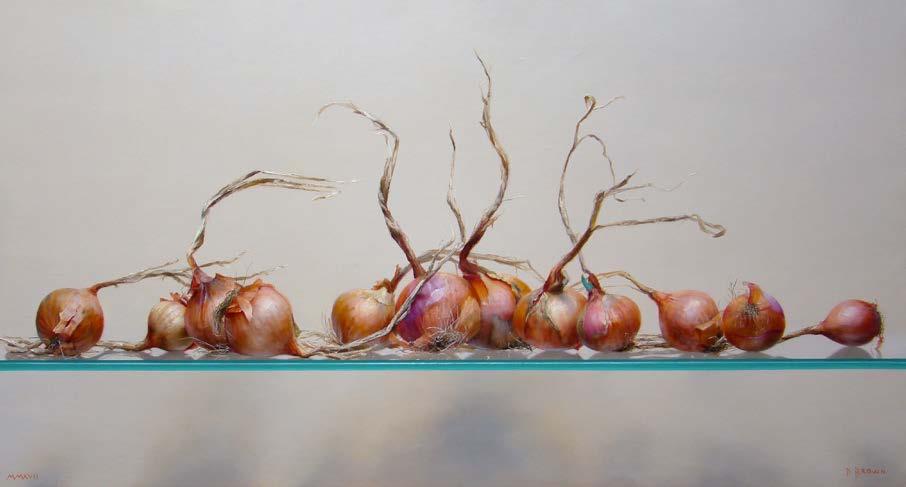
146
Paul S. Brown
Onions on Glass Oil on Canvas 45 x 80 cms / 17¾" x 31½"
147
American, (Contemporary)
Grapes and Mandarins

Oil on Panel
70 x 60 cms / 27½" x 23½"
148
Willem Dolphyn Belgian, (1935-2016)
Willem Dolphyn
Belgian, (1935-2016)
Instantly recognisable as the master of still life painting in Antwerp. Demonstrating the sheer technical virtuosity in the handling of light, texture and atmosphere, his works contain a rich purity which sets them apart from others.

Willem gained a great deal of experience and professional knowledge from his father Victor, who was a teacher at the Academy and the founder of the new Classic School of Traditional painting. This developed Willem’s keen understanding of composition, detail and colour.
For Willem the most important thing in life was his painting. He worked in his studio off Venustraat from 1963 to his death in 2016. For over 50 years, from that one spot, Willem created around 2,500 paintings. A monumental achievement for one man.
Willem was an avid collector of traditional Japanese armour, Dutch Roemer glassware, Arabian fabrics and ceramics which he carefully composed into his still life paintings. The rooms were crowded with historic furniture, the shelves were loaded with treasures, fabrics, glassware and ceramics which span the centuries, gleaming and glinting in the Northern light, each piece collected with pride and all contributing to his incredible compositions. The ideas for these compositions came to Willem during the night. Even in his dreams he worked, seeing Roman glass, Delft tiles, Flemish tapestry, fine fruits and expensive china drawn from across the continent and coming all together in his mind. Willem often undertook commissions for friends, family and his collectors. Portraits, cherished places or his exceptional still lifes created with that personal touch to strike an enduring chord.
W. H. Patterson held Willem’s first solo exhibition at in 1985 to great acclaim. Sell out shows became a regular feature as Patterson’s clients embraced Willem’s supreme talent and enhanced their collections with his spectacular composotions.
Black Forest Cherries
Oil on Panel 30 x 40 cms / 11½" x 15"
149

Pieter Wagemans
Belgian, (Contemporary)
Building on the legacy of the Dutch Masters, Pieter Wagemans’ transcendent still life paintings have propelled the artist to the forefront of contemporary realist painting. Pieter studied at the Royal Academy of Fine Arts in Antwerp and was inspired by the Dutch still life painters David de Heem, Willem Heda and Rachel Ruys.
Pieter carefully composes each floral arrangement in his studio in Antwerp. This enables the artist to control the effect of light and the transitory nature of his subjects. Pieter bypasses the use of underpainting and paints each flower in turn, 'alla prima', so that each flower is captured in its prime. Sometimes this can take a whole day, others only a few hours. Often the flower compositions never existed in reality because the flowers were painted one by one over several weeks.
The fine painting of flowers demands considerable discipline, because the passing of time is an important challenge. A flower is always changing. Looking for symbolic value of a composition he builds a moving story. The ‘vanitas’ motif is a major source of inspiration. Reflecting on the transitory nature of life, beauty often is incorporated in the form of a flower.
Recognisable for the balance of light and shadow within elegantly composed floral vignettes, an exquisite colour harmony and intricate details, Pieter’s work appeals to and resonates with the contemporary collector.
Last Summer Flowers
Oil on Canvas 95 x 75 cms / 37½" x 29½" 151
Still Life with Red Tulips

Painted in 1972
Oil on canvas
51 x 60 cms / 20" x 23½”
Provenance
Private Collection, Florida.
152
Mary Nicol Neil Armour
Scottish, (1902-2000)
In the early twentieth-century Scotland found itself one of the leading centres of European artistic culture: producing a succession of movements in direct dialogue with first Impressionism, and then modernism. Where Glasgow and its renowned School of Art would produce the loose, realist brushwork of the Glasgow Boys and Glasgow Girls, Edinburgh would birth the startling boldness of the Scottish Colourists. In Mary Nicol Neill Armour, the last surviving artist to have worked during this heyday, we find the best of both traditions. Through planes of vivid colour and richly textured brushwork Armour brought a unique vitality to her still lives and landscapes. Winning acclaim from all quarters, she would eventually rise to become President of the Glasgow School: a fitting acknowledgement of Armour’s immense status.
Mary Nicol Neill Armour (née Steel) was born in Lanarkshire in 1902 to a family of Steel workers. The eldest of six children she excelled academically from a young age, and would win a rare scholarship to study at Hamilton Academy at the age of 12. Although she originally wanted to become an educator her art tutor, the well-known watercolourist Penelope Beaton, would encourage her to pursue a career as a painter. In 1920, Beaton would help persuage Mary’s father to help her enrol at the Glasgow School of art, where she would study for 5 years. Glasgow and its art school were at that time one of the leading centres of modern painting, with the influence of the Scottish Colourists, Glasgow Girls and Glasgow Boys all keenly felt by those studying in the city. Armour’s best known works, her highly coloured still lives, were created in direct dialogue with these movements. After graduation, Armour would become an art teacher in Glasgow to supplement her income, and in 1927 she would marry fellow painter William Armour. Although deeply in love, her marriage would force her to give up her teaching post, as the laws of the time prevented married women from working as educators. While this move gave her more time to paint, evidence by her exhibitions at the RA and receipt of the prestigious Guthrie prize in 1937, she rightly felt cheated. Thankfully, when the prohibitive legislation was repealed after the Second World War Armour would join the Glasgow School of Art as their still life painting professor. The return to teaching would inspire a new wave of creativity in the artist, helped by the fact that many of her students were returning servicemen who had been greatly influenced by modern European art.
Driven to adopt brighter colour and more fluid brushstrokes, Armour would retire in 1962 to paint full time: this decision would usher in the most productive and successful period fo her career. Winning the Cargill Prize in 1972, she would also find herself elected Honorary President of both the Glasgow Institute of Fine Arts and the Glasgow School of Arts. After ceasing painting in 1988 due to failing eyesight, Armour would spend her final years with her family, passing away at the age of 98. To this day her artistic achievements and contribution to education are recognised in the Armour Award, given annually to a young artist of distinction.
153
Gladwell & Patterson, London
A stones throw away from Harrods, in London's prestigious Knightsbridge, our gallery offers the very finest artworks in a luxurious and comfortable setting. Visit us for a coffee or glass of champagne on your next visit to London.

5 Beauchamp Place, Knightsbridge, London, SW3 1NG
Tel: + 44 (0) 207 584 5512
Email: emily@gladwellpatterson.com
Open: Monday - Friday 10am - 6pm / Saturday 11am - 4pm
154
Gladwells Rutland, Oakham

Situated in a beautiful historic market town in the very heart of Rutland, England’s smallest county, our country outpost has become a must visit destination for many. Away from the hustle and bustle of London, it is definitely worth taking the time to come and visit us here.
23b Mill Street
Oakham, Rutland, LE15 6EA
Open: Monday - Friday 10am - 4pm, / Saturday 11am - 3pm
155
Tel: + 44 (0) 1572 756518
Email: rutland@gladwellpatterson.com
Index
Agapito Casas Abarca p.34
Adam Emory Albright p.84-87
Matthew Alexander p.79
Filippo Anivitti p.81
Mary Nicol Neil Armour p.152-153
Georges Bauquier p.98-101
Francesco Bergamini p.82
Auguste Bouvard p.56
Paul S. Brown p.142-147
Renèe Carpentier Wintz p.53
Édouard Cortès p.70-71
Willem Dolphyn p.148-149
Margaret Dovaston p.83
Donald Hamilton Fraser p.110-113
Ivon Hitchens p.118-125
Alexandre Louis Jacob p.38-45
Clarissa James p.128-131
Henri Le Sidaner p.66-69
David Leverett p.106-109
Gustave Loiseau p.2-23
For further information on any of these artworks please contact the gallery
Glenn Fuller (Director) glenn@gladwellpatterson.com +44 (0)776 782 4245
Research: Will Stewart and Ella Wells, Design: Ella Wells
All Rights Reserved Gladwell & Patterson, 2023
Maximilien Luce p.58-61
Paul Madeline p.46
Georges Marionez p.57
Maurice Martin p.64-65
Francisco Miralles Y Galup p.80
Pierre-Eugène Montézin p.32-33
Ronny Moortgat p.72-76
Sir Alfred James Munnings p.138-141
Jean-Baptiste Olive p.47
Charles Perron p.54-55
Pablo Picasso p.90-98
Georges Ricard-Cordingley p.35
Georges Charles Robin p.24-31
Dorothea Sharp p.88-89
David Shepherd p.132-137
Georges Terzian p. 102-105
Charles Henri Verbrugghe p.62-63
Pieter Wagemans p.150-151
Kenneth Webb p.126-127
Peter Wileman p.114-117
Raymond Wintz p.48-52
156
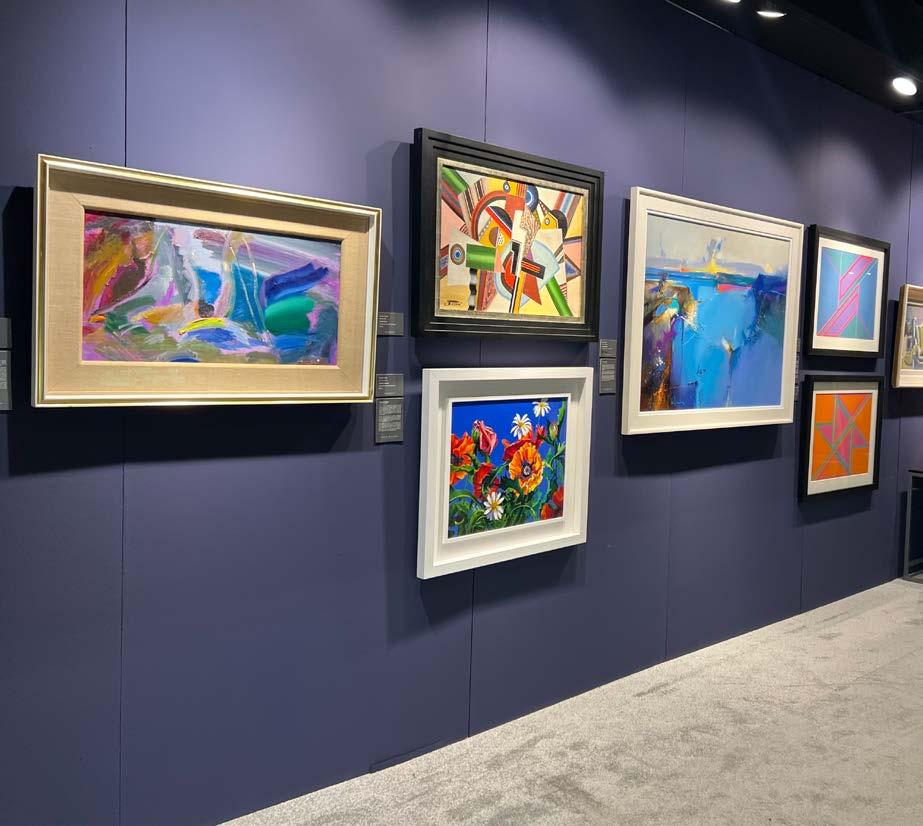
5 Beauchamp Place, London SW3 1NG • +44 (0)20 7584 5512 • glenn@gladwellpatterson.com • gladwellpatterson.com

































































































































